Business Decision Planning - Analysis of Supermarket Market, Customer Behaviour and Problems Faced
VerifiedAdded on 2023/06/15
|24
|6333
|165
AI Summary
This analysis focuses on conducting research on the market for supermarkets, customer’s buying patterns, promotional policies and the various problems which the supermarkets are facing. The research will be applying primary method and secondary method of data collection. The data collection will be done for the following areas such as buying patterns, promotion efforts of the supermarkets, satisfaction level of the customers and problems faced by the supermarkets. The research is conducted so that Salus Supermarket can obtain an overall understanding of the market and makes strategies so that the business can get a competitive advantage over its rivals.
Contribute Materials
Your contribution can guide someone’s learning journey. Share your
documents today.
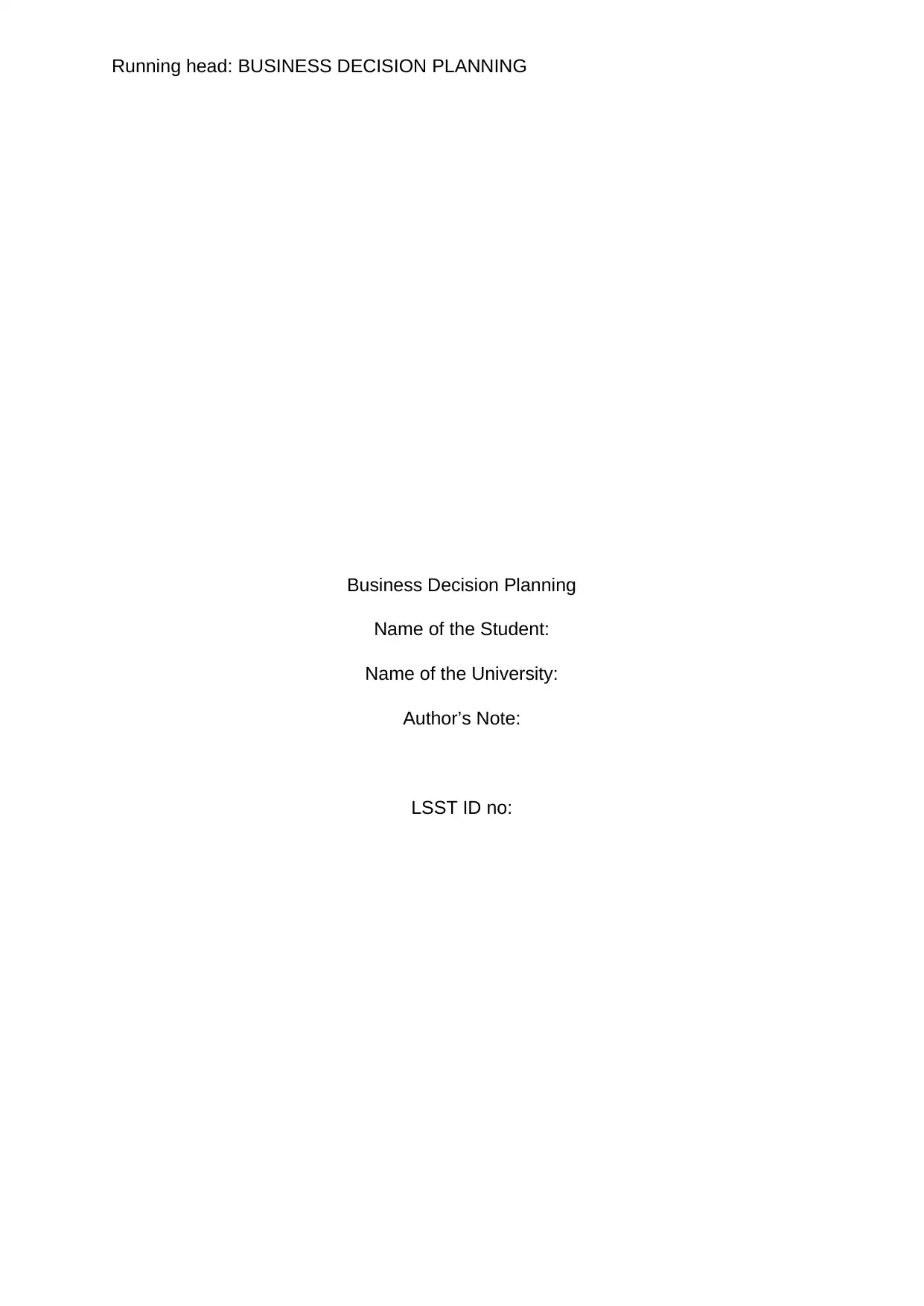
Running head: BUSINESS DECISION PLANNING
Business Decision Planning
Name of the Student:
Name of the University:
Author’s Note:
LSST ID no:
Business Decision Planning
Name of the Student:
Name of the University:
Author’s Note:
LSST ID no:
Secure Best Marks with AI Grader
Need help grading? Try our AI Grader for instant feedback on your assignments.
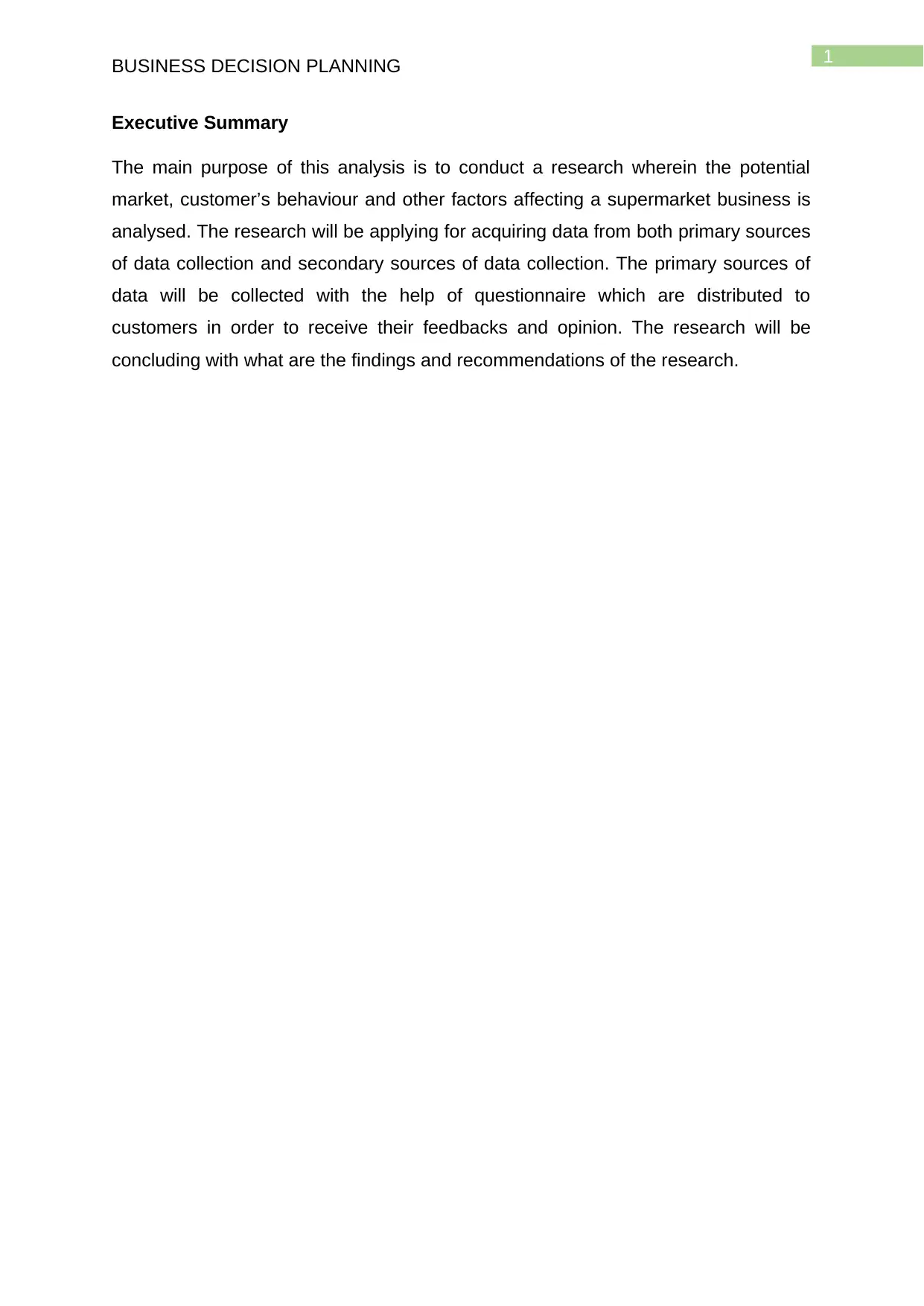
1
BUSINESS DECISION PLANNING
Executive Summary
The main purpose of this analysis is to conduct a research wherein the potential
market, customer’s behaviour and other factors affecting a supermarket business is
analysed. The research will be applying for acquiring data from both primary sources
of data collection and secondary sources of data collection. The primary sources of
data will be collected with the help of questionnaire which are distributed to
customers in order to receive their feedbacks and opinion. The research will be
concluding with what are the findings and recommendations of the research.
BUSINESS DECISION PLANNING
Executive Summary
The main purpose of this analysis is to conduct a research wherein the potential
market, customer’s behaviour and other factors affecting a supermarket business is
analysed. The research will be applying for acquiring data from both primary sources
of data collection and secondary sources of data collection. The primary sources of
data will be collected with the help of questionnaire which are distributed to
customers in order to receive their feedbacks and opinion. The research will be
concluding with what are the findings and recommendations of the research.
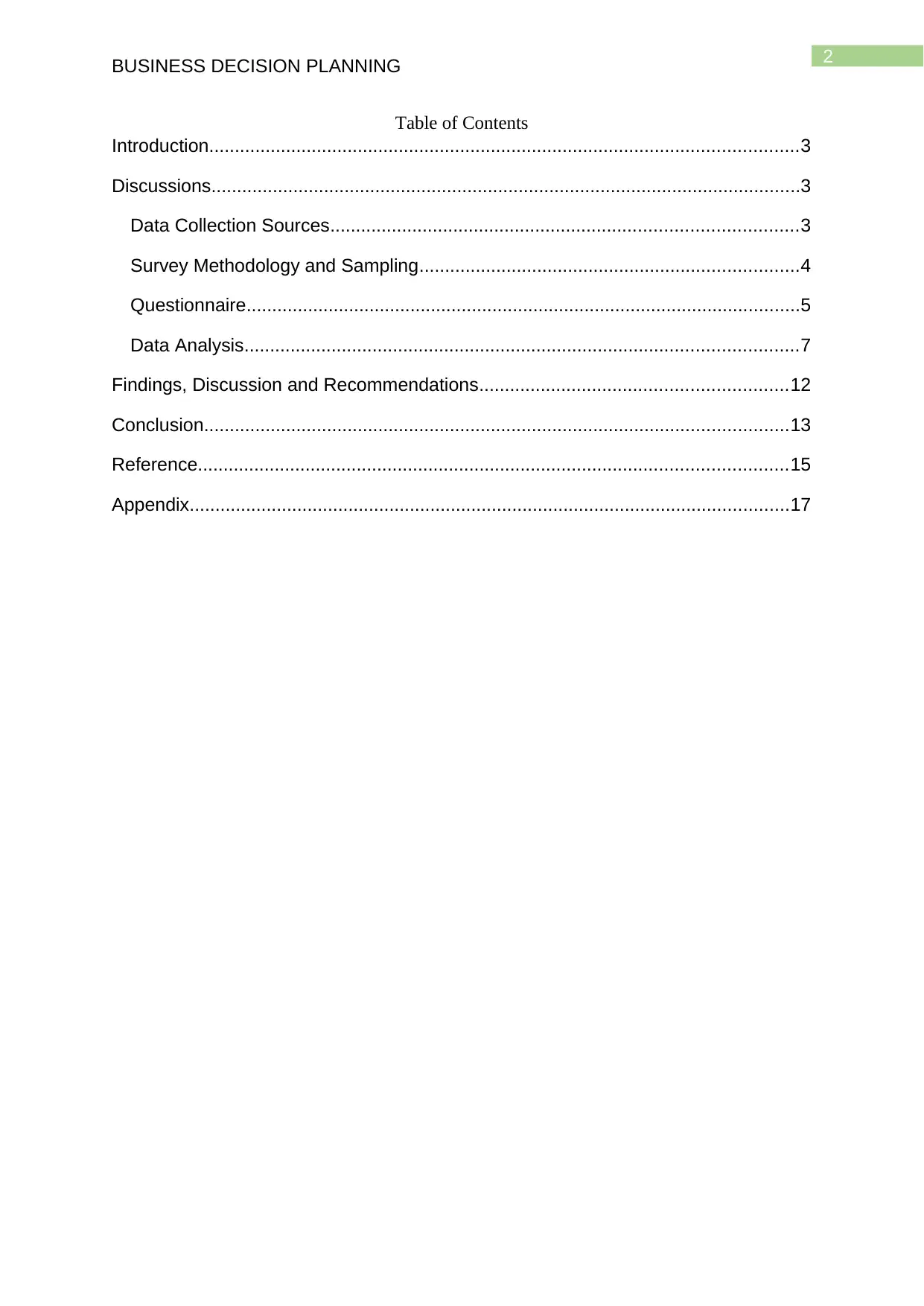
2
BUSINESS DECISION PLANNING
Table of Contents
Introduction...................................................................................................................3
Discussions...................................................................................................................3
Data Collection Sources...........................................................................................3
Survey Methodology and Sampling..........................................................................4
Questionnaire............................................................................................................5
Data Analysis............................................................................................................7
Findings, Discussion and Recommendations............................................................12
Conclusion..................................................................................................................13
Reference...................................................................................................................15
Appendix.....................................................................................................................17
BUSINESS DECISION PLANNING
Table of Contents
Introduction...................................................................................................................3
Discussions...................................................................................................................3
Data Collection Sources...........................................................................................3
Survey Methodology and Sampling..........................................................................4
Questionnaire............................................................................................................5
Data Analysis............................................................................................................7
Findings, Discussion and Recommendations............................................................12
Conclusion..................................................................................................................13
Reference...................................................................................................................15
Appendix.....................................................................................................................17
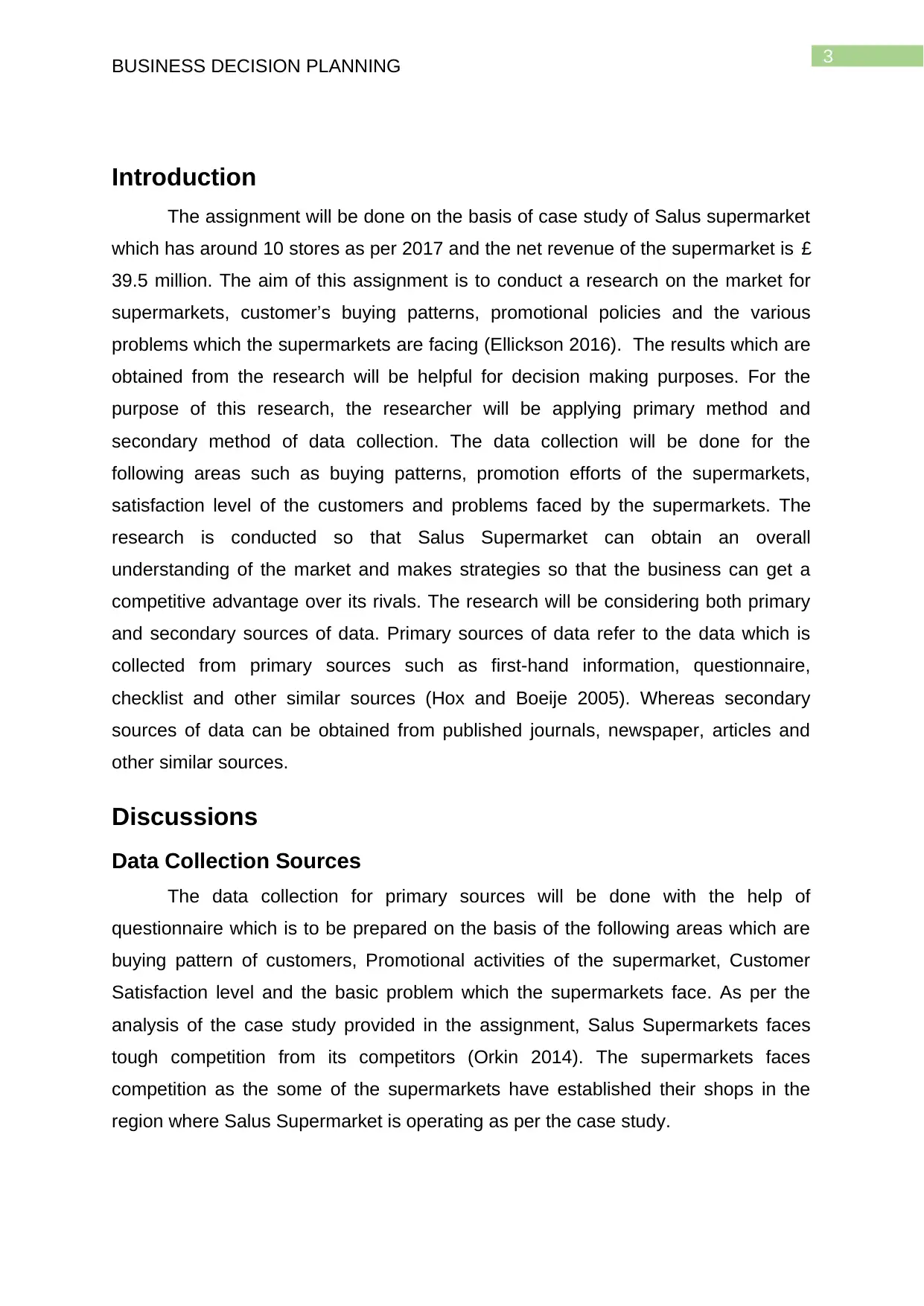
3
BUSINESS DECISION PLANNING
Introduction
The assignment will be done on the basis of case study of Salus supermarket
which has around 10 stores as per 2017 and the net revenue of the supermarket is £
39.5 million. The aim of this assignment is to conduct a research on the market for
supermarkets, customer’s buying patterns, promotional policies and the various
problems which the supermarkets are facing (Ellickson 2016). The results which are
obtained from the research will be helpful for decision making purposes. For the
purpose of this research, the researcher will be applying primary method and
secondary method of data collection. The data collection will be done for the
following areas such as buying patterns, promotion efforts of the supermarkets,
satisfaction level of the customers and problems faced by the supermarkets. The
research is conducted so that Salus Supermarket can obtain an overall
understanding of the market and makes strategies so that the business can get a
competitive advantage over its rivals. The research will be considering both primary
and secondary sources of data. Primary sources of data refer to the data which is
collected from primary sources such as first-hand information, questionnaire,
checklist and other similar sources (Hox and Boeije 2005). Whereas secondary
sources of data can be obtained from published journals, newspaper, articles and
other similar sources.
Discussions
Data Collection Sources
The data collection for primary sources will be done with the help of
questionnaire which is to be prepared on the basis of the following areas which are
buying pattern of customers, Promotional activities of the supermarket, Customer
Satisfaction level and the basic problem which the supermarkets face. As per the
analysis of the case study provided in the assignment, Salus Supermarkets faces
tough competition from its competitors (Orkin 2014). The supermarkets faces
competition as the some of the supermarkets have established their shops in the
region where Salus Supermarket is operating as per the case study.
BUSINESS DECISION PLANNING
Introduction
The assignment will be done on the basis of case study of Salus supermarket
which has around 10 stores as per 2017 and the net revenue of the supermarket is £
39.5 million. The aim of this assignment is to conduct a research on the market for
supermarkets, customer’s buying patterns, promotional policies and the various
problems which the supermarkets are facing (Ellickson 2016). The results which are
obtained from the research will be helpful for decision making purposes. For the
purpose of this research, the researcher will be applying primary method and
secondary method of data collection. The data collection will be done for the
following areas such as buying patterns, promotion efforts of the supermarkets,
satisfaction level of the customers and problems faced by the supermarkets. The
research is conducted so that Salus Supermarket can obtain an overall
understanding of the market and makes strategies so that the business can get a
competitive advantage over its rivals. The research will be considering both primary
and secondary sources of data. Primary sources of data refer to the data which is
collected from primary sources such as first-hand information, questionnaire,
checklist and other similar sources (Hox and Boeije 2005). Whereas secondary
sources of data can be obtained from published journals, newspaper, articles and
other similar sources.
Discussions
Data Collection Sources
The data collection for primary sources will be done with the help of
questionnaire which is to be prepared on the basis of the following areas which are
buying pattern of customers, Promotional activities of the supermarket, Customer
Satisfaction level and the basic problem which the supermarkets face. As per the
analysis of the case study provided in the assignment, Salus Supermarkets faces
tough competition from its competitors (Orkin 2014). The supermarkets faces
competition as the some of the supermarkets have established their shops in the
region where Salus Supermarket is operating as per the case study.
Secure Best Marks with AI Grader
Need help grading? Try our AI Grader for instant feedback on your assignments.
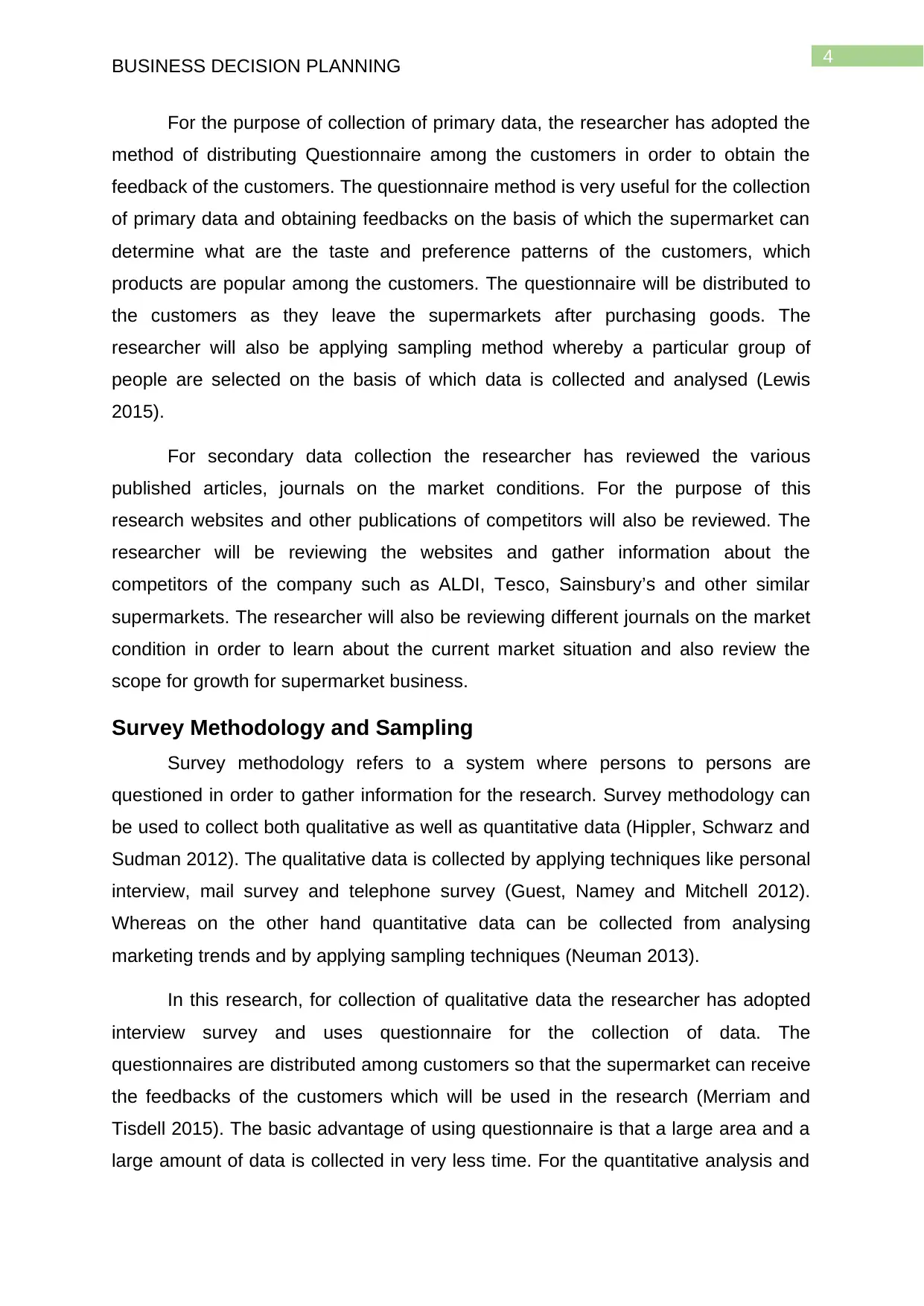
4
BUSINESS DECISION PLANNING
For the purpose of collection of primary data, the researcher has adopted the
method of distributing Questionnaire among the customers in order to obtain the
feedback of the customers. The questionnaire method is very useful for the collection
of primary data and obtaining feedbacks on the basis of which the supermarket can
determine what are the taste and preference patterns of the customers, which
products are popular among the customers. The questionnaire will be distributed to
the customers as they leave the supermarkets after purchasing goods. The
researcher will also be applying sampling method whereby a particular group of
people are selected on the basis of which data is collected and analysed (Lewis
2015).
For secondary data collection the researcher has reviewed the various
published articles, journals on the market conditions. For the purpose of this
research websites and other publications of competitors will also be reviewed. The
researcher will be reviewing the websites and gather information about the
competitors of the company such as ALDI, Tesco, Sainsbury’s and other similar
supermarkets. The researcher will also be reviewing different journals on the market
condition in order to learn about the current market situation and also review the
scope for growth for supermarket business.
Survey Methodology and Sampling
Survey methodology refers to a system where persons to persons are
questioned in order to gather information for the research. Survey methodology can
be used to collect both qualitative as well as quantitative data (Hippler, Schwarz and
Sudman 2012). The qualitative data is collected by applying techniques like personal
interview, mail survey and telephone survey (Guest, Namey and Mitchell 2012).
Whereas on the other hand quantitative data can be collected from analysing
marketing trends and by applying sampling techniques (Neuman 2013).
In this research, for collection of qualitative data the researcher has adopted
interview survey and uses questionnaire for the collection of data. The
questionnaires are distributed among customers so that the supermarket can receive
the feedbacks of the customers which will be used in the research (Merriam and
Tisdell 2015). The basic advantage of using questionnaire is that a large area and a
large amount of data is collected in very less time. For the quantitative analysis and
BUSINESS DECISION PLANNING
For the purpose of collection of primary data, the researcher has adopted the
method of distributing Questionnaire among the customers in order to obtain the
feedback of the customers. The questionnaire method is very useful for the collection
of primary data and obtaining feedbacks on the basis of which the supermarket can
determine what are the taste and preference patterns of the customers, which
products are popular among the customers. The questionnaire will be distributed to
the customers as they leave the supermarkets after purchasing goods. The
researcher will also be applying sampling method whereby a particular group of
people are selected on the basis of which data is collected and analysed (Lewis
2015).
For secondary data collection the researcher has reviewed the various
published articles, journals on the market conditions. For the purpose of this
research websites and other publications of competitors will also be reviewed. The
researcher will be reviewing the websites and gather information about the
competitors of the company such as ALDI, Tesco, Sainsbury’s and other similar
supermarkets. The researcher will also be reviewing different journals on the market
condition in order to learn about the current market situation and also review the
scope for growth for supermarket business.
Survey Methodology and Sampling
Survey methodology refers to a system where persons to persons are
questioned in order to gather information for the research. Survey methodology can
be used to collect both qualitative as well as quantitative data (Hippler, Schwarz and
Sudman 2012). The qualitative data is collected by applying techniques like personal
interview, mail survey and telephone survey (Guest, Namey and Mitchell 2012).
Whereas on the other hand quantitative data can be collected from analysing
marketing trends and by applying sampling techniques (Neuman 2013).
In this research, for collection of qualitative data the researcher has adopted
interview survey and uses questionnaire for the collection of data. The
questionnaires are distributed among customers so that the supermarket can receive
the feedbacks of the customers which will be used in the research (Merriam and
Tisdell 2015). The basic advantage of using questionnaire is that a large area and a
large amount of data is collected in very less time. For the quantitative analysis and
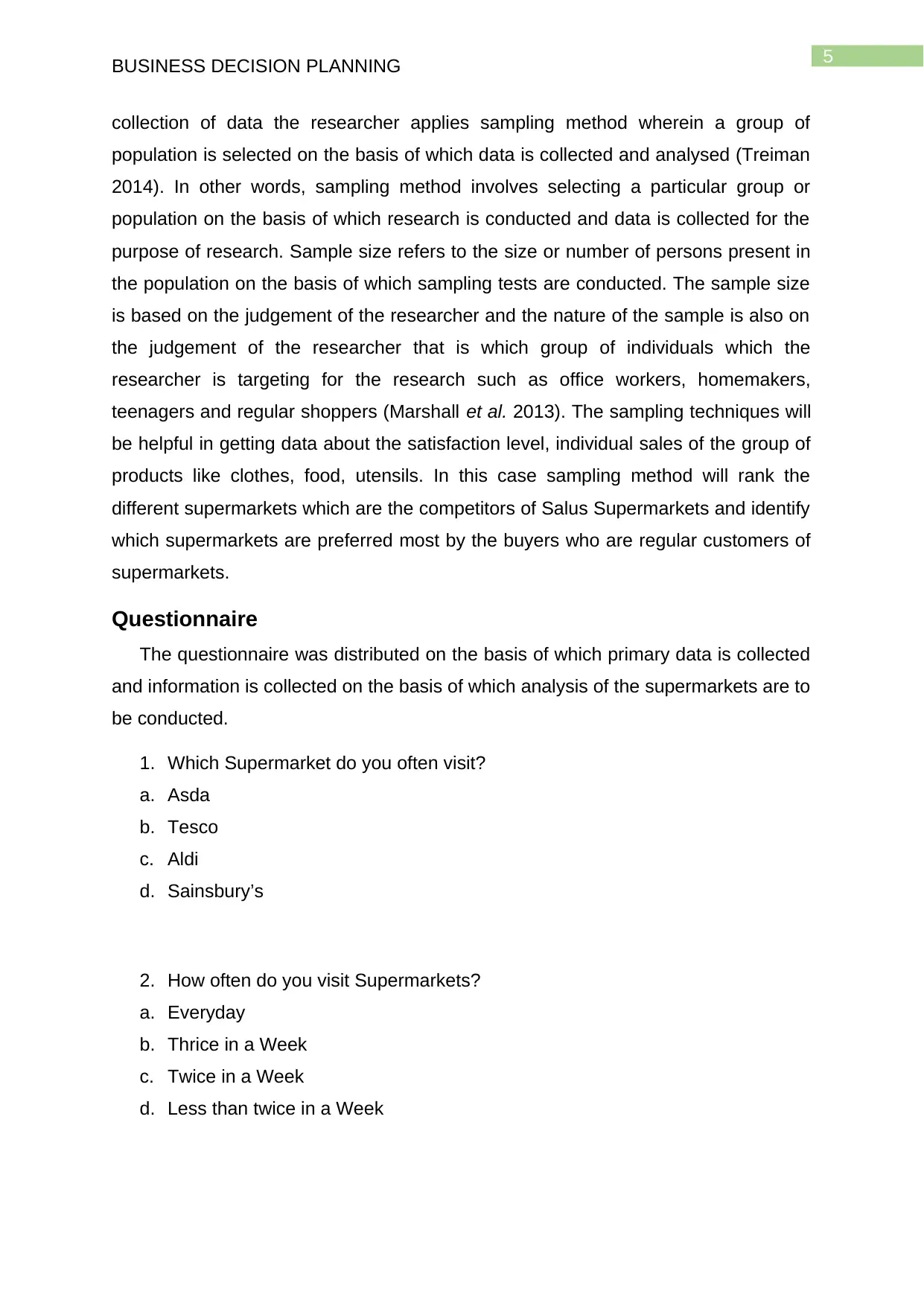
5
BUSINESS DECISION PLANNING
collection of data the researcher applies sampling method wherein a group of
population is selected on the basis of which data is collected and analysed (Treiman
2014). In other words, sampling method involves selecting a particular group or
population on the basis of which research is conducted and data is collected for the
purpose of research. Sample size refers to the size or number of persons present in
the population on the basis of which sampling tests are conducted. The sample size
is based on the judgement of the researcher and the nature of the sample is also on
the judgement of the researcher that is which group of individuals which the
researcher is targeting for the research such as office workers, homemakers,
teenagers and regular shoppers (Marshall et al. 2013). The sampling techniques will
be helpful in getting data about the satisfaction level, individual sales of the group of
products like clothes, food, utensils. In this case sampling method will rank the
different supermarkets which are the competitors of Salus Supermarkets and identify
which supermarkets are preferred most by the buyers who are regular customers of
supermarkets.
Questionnaire
The questionnaire was distributed on the basis of which primary data is collected
and information is collected on the basis of which analysis of the supermarkets are to
be conducted.
1. Which Supermarket do you often visit?
a. Asda
b. Tesco
c. Aldi
d. Sainsbury’s
2. How often do you visit Supermarkets?
a. Everyday
b. Thrice in a Week
c. Twice in a Week
d. Less than twice in a Week
BUSINESS DECISION PLANNING
collection of data the researcher applies sampling method wherein a group of
population is selected on the basis of which data is collected and analysed (Treiman
2014). In other words, sampling method involves selecting a particular group or
population on the basis of which research is conducted and data is collected for the
purpose of research. Sample size refers to the size or number of persons present in
the population on the basis of which sampling tests are conducted. The sample size
is based on the judgement of the researcher and the nature of the sample is also on
the judgement of the researcher that is which group of individuals which the
researcher is targeting for the research such as office workers, homemakers,
teenagers and regular shoppers (Marshall et al. 2013). The sampling techniques will
be helpful in getting data about the satisfaction level, individual sales of the group of
products like clothes, food, utensils. In this case sampling method will rank the
different supermarkets which are the competitors of Salus Supermarkets and identify
which supermarkets are preferred most by the buyers who are regular customers of
supermarkets.
Questionnaire
The questionnaire was distributed on the basis of which primary data is collected
and information is collected on the basis of which analysis of the supermarkets are to
be conducted.
1. Which Supermarket do you often visit?
a. Asda
b. Tesco
c. Aldi
d. Sainsbury’s
2. How often do you visit Supermarkets?
a. Everyday
b. Thrice in a Week
c. Twice in a Week
d. Less than twice in a Week
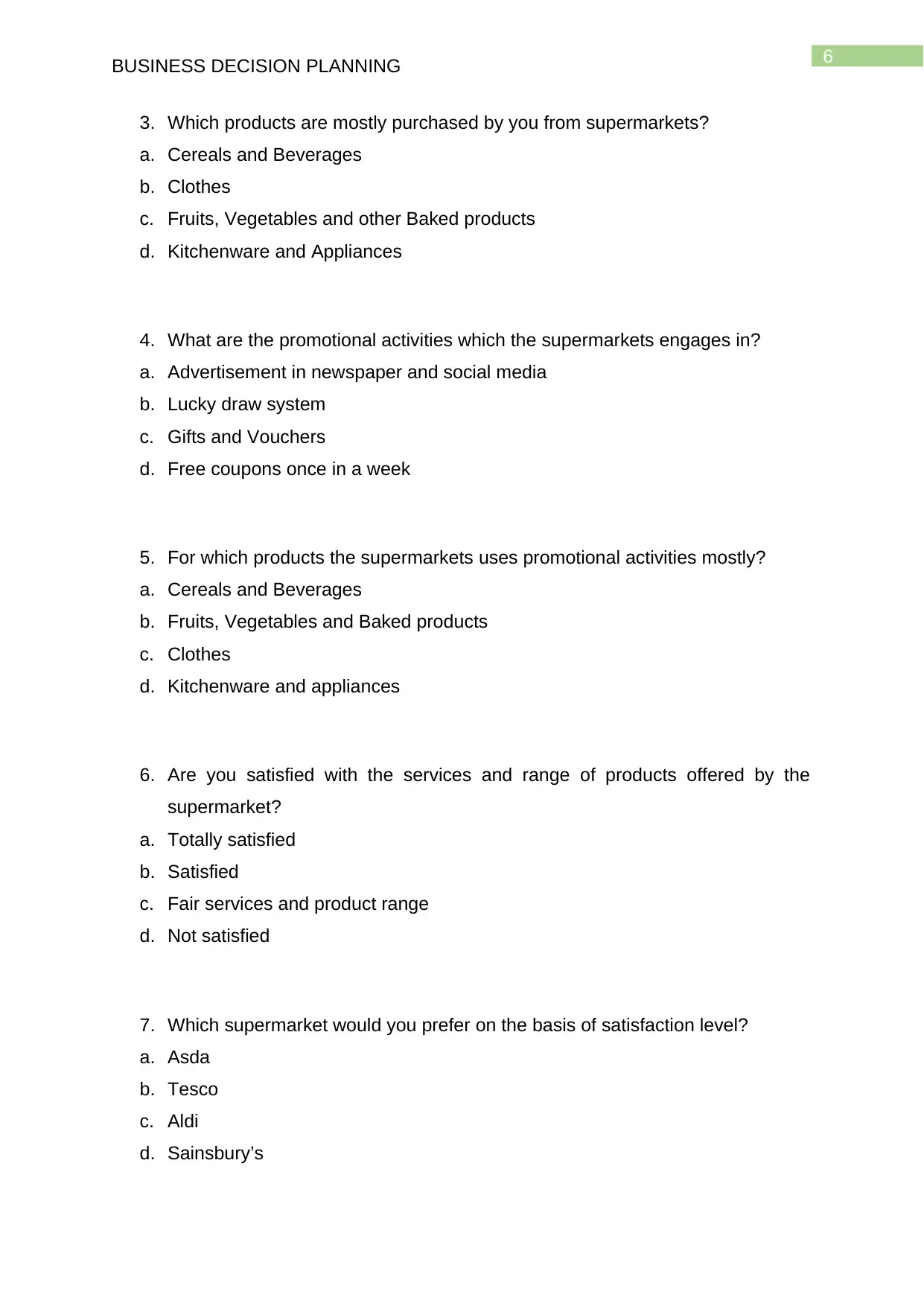
6
BUSINESS DECISION PLANNING
3. Which products are mostly purchased by you from supermarkets?
a. Cereals and Beverages
b. Clothes
c. Fruits, Vegetables and other Baked products
d. Kitchenware and Appliances
4. What are the promotional activities which the supermarkets engages in?
a. Advertisement in newspaper and social media
b. Lucky draw system
c. Gifts and Vouchers
d. Free coupons once in a week
5. For which products the supermarkets uses promotional activities mostly?
a. Cereals and Beverages
b. Fruits, Vegetables and Baked products
c. Clothes
d. Kitchenware and appliances
6. Are you satisfied with the services and range of products offered by the
supermarket?
a. Totally satisfied
b. Satisfied
c. Fair services and product range
d. Not satisfied
7. Which supermarket would you prefer on the basis of satisfaction level?
a. Asda
b. Tesco
c. Aldi
d. Sainsbury’s
BUSINESS DECISION PLANNING
3. Which products are mostly purchased by you from supermarkets?
a. Cereals and Beverages
b. Clothes
c. Fruits, Vegetables and other Baked products
d. Kitchenware and Appliances
4. What are the promotional activities which the supermarkets engages in?
a. Advertisement in newspaper and social media
b. Lucky draw system
c. Gifts and Vouchers
d. Free coupons once in a week
5. For which products the supermarkets uses promotional activities mostly?
a. Cereals and Beverages
b. Fruits, Vegetables and Baked products
c. Clothes
d. Kitchenware and appliances
6. Are you satisfied with the services and range of products offered by the
supermarket?
a. Totally satisfied
b. Satisfied
c. Fair services and product range
d. Not satisfied
7. Which supermarket would you prefer on the basis of satisfaction level?
a. Asda
b. Tesco
c. Aldi
d. Sainsbury’s
Paraphrase This Document
Need a fresh take? Get an instant paraphrase of this document with our AI Paraphraser
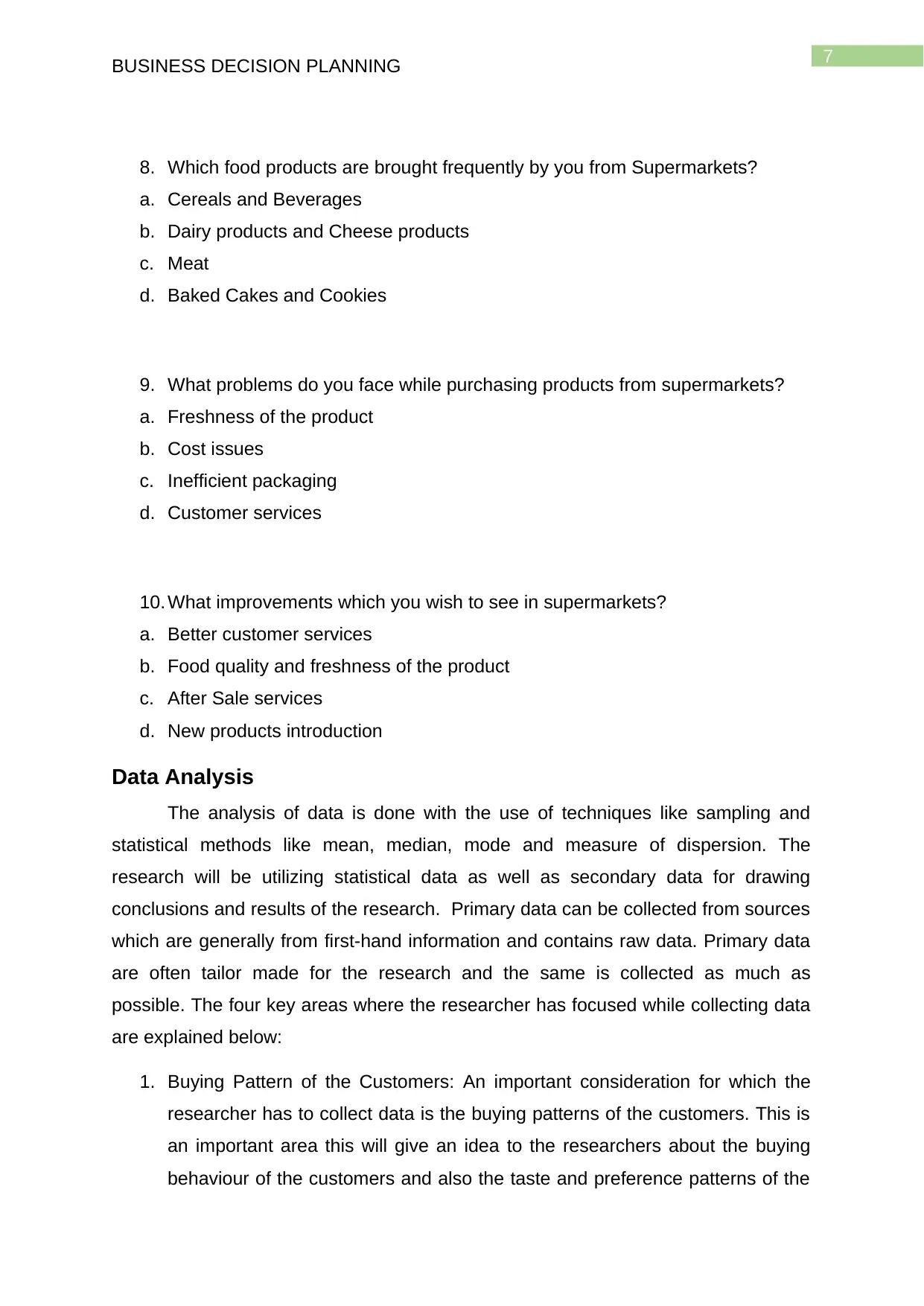
7
BUSINESS DECISION PLANNING
8. Which food products are brought frequently by you from Supermarkets?
a. Cereals and Beverages
b. Dairy products and Cheese products
c. Meat
d. Baked Cakes and Cookies
9. What problems do you face while purchasing products from supermarkets?
a. Freshness of the product
b. Cost issues
c. Inefficient packaging
d. Customer services
10. What improvements which you wish to see in supermarkets?
a. Better customer services
b. Food quality and freshness of the product
c. After Sale services
d. New products introduction
Data Analysis
The analysis of data is done with the use of techniques like sampling and
statistical methods like mean, median, mode and measure of dispersion. The
research will be utilizing statistical data as well as secondary data for drawing
conclusions and results of the research. Primary data can be collected from sources
which are generally from first-hand information and contains raw data. Primary data
are often tailor made for the research and the same is collected as much as
possible. The four key areas where the researcher has focused while collecting data
are explained below:
1. Buying Pattern of the Customers: An important consideration for which the
researcher has to collect data is the buying patterns of the customers. This is
an important area this will give an idea to the researchers about the buying
behaviour of the customers and also the taste and preference patterns of the
BUSINESS DECISION PLANNING
8. Which food products are brought frequently by you from Supermarkets?
a. Cereals and Beverages
b. Dairy products and Cheese products
c. Meat
d. Baked Cakes and Cookies
9. What problems do you face while purchasing products from supermarkets?
a. Freshness of the product
b. Cost issues
c. Inefficient packaging
d. Customer services
10. What improvements which you wish to see in supermarkets?
a. Better customer services
b. Food quality and freshness of the product
c. After Sale services
d. New products introduction
Data Analysis
The analysis of data is done with the use of techniques like sampling and
statistical methods like mean, median, mode and measure of dispersion. The
research will be utilizing statistical data as well as secondary data for drawing
conclusions and results of the research. Primary data can be collected from sources
which are generally from first-hand information and contains raw data. Primary data
are often tailor made for the research and the same is collected as much as
possible. The four key areas where the researcher has focused while collecting data
are explained below:
1. Buying Pattern of the Customers: An important consideration for which the
researcher has to collect data is the buying patterns of the customers. This is
an important area this will give an idea to the researchers about the buying
behaviour of the customers and also the taste and preference patterns of the
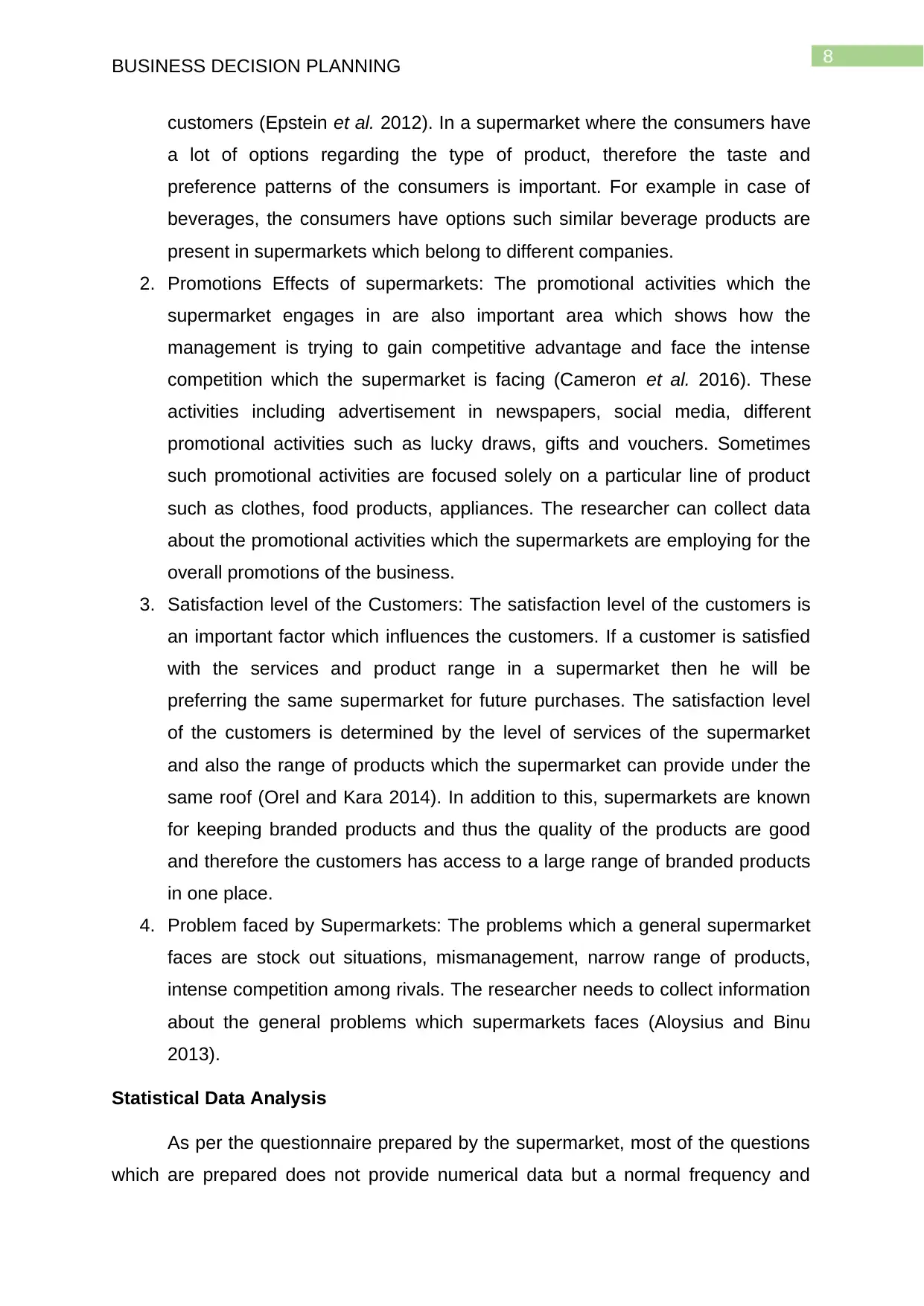
8
BUSINESS DECISION PLANNING
customers (Epstein et al. 2012). In a supermarket where the consumers have
a lot of options regarding the type of product, therefore the taste and
preference patterns of the consumers is important. For example in case of
beverages, the consumers have options such similar beverage products are
present in supermarkets which belong to different companies.
2. Promotions Effects of supermarkets: The promotional activities which the
supermarket engages in are also important area which shows how the
management is trying to gain competitive advantage and face the intense
competition which the supermarket is facing (Cameron et al. 2016). These
activities including advertisement in newspapers, social media, different
promotional activities such as lucky draws, gifts and vouchers. Sometimes
such promotional activities are focused solely on a particular line of product
such as clothes, food products, appliances. The researcher can collect data
about the promotional activities which the supermarkets are employing for the
overall promotions of the business.
3. Satisfaction level of the Customers: The satisfaction level of the customers is
an important factor which influences the customers. If a customer is satisfied
with the services and product range in a supermarket then he will be
preferring the same supermarket for future purchases. The satisfaction level
of the customers is determined by the level of services of the supermarket
and also the range of products which the supermarket can provide under the
same roof (Orel and Kara 2014). In addition to this, supermarkets are known
for keeping branded products and thus the quality of the products are good
and therefore the customers has access to a large range of branded products
in one place.
4. Problem faced by Supermarkets: The problems which a general supermarket
faces are stock out situations, mismanagement, narrow range of products,
intense competition among rivals. The researcher needs to collect information
about the general problems which supermarkets faces (Aloysius and Binu
2013).
Statistical Data Analysis
As per the questionnaire prepared by the supermarket, most of the questions
which are prepared does not provide numerical data but a normal frequency and
BUSINESS DECISION PLANNING
customers (Epstein et al. 2012). In a supermarket where the consumers have
a lot of options regarding the type of product, therefore the taste and
preference patterns of the consumers is important. For example in case of
beverages, the consumers have options such similar beverage products are
present in supermarkets which belong to different companies.
2. Promotions Effects of supermarkets: The promotional activities which the
supermarket engages in are also important area which shows how the
management is trying to gain competitive advantage and face the intense
competition which the supermarket is facing (Cameron et al. 2016). These
activities including advertisement in newspapers, social media, different
promotional activities such as lucky draws, gifts and vouchers. Sometimes
such promotional activities are focused solely on a particular line of product
such as clothes, food products, appliances. The researcher can collect data
about the promotional activities which the supermarkets are employing for the
overall promotions of the business.
3. Satisfaction level of the Customers: The satisfaction level of the customers is
an important factor which influences the customers. If a customer is satisfied
with the services and product range in a supermarket then he will be
preferring the same supermarket for future purchases. The satisfaction level
of the customers is determined by the level of services of the supermarket
and also the range of products which the supermarket can provide under the
same roof (Orel and Kara 2014). In addition to this, supermarkets are known
for keeping branded products and thus the quality of the products are good
and therefore the customers has access to a large range of branded products
in one place.
4. Problem faced by Supermarkets: The problems which a general supermarket
faces are stock out situations, mismanagement, narrow range of products,
intense competition among rivals. The researcher needs to collect information
about the general problems which supermarkets faces (Aloysius and Binu
2013).
Statistical Data Analysis
As per the questionnaire prepared by the supermarket, most of the questions
which are prepared does not provide numerical data but a normal frequency and

9
BUSINESS DECISION PLANNING
therefore the analysis of mean, median, mode and measure of dispersion is done for
the question whether the customers are satisfied with the services and range of
products which are provided by the supermarkets (Busk and Marascuilo 2015). The
table below shows the statistical data analysis which is prepared on the basis of the
questionnaire:
Are you satisfied with the services and range of products offered by the
supermarket? Results
Mean 2.2
Standard Error 0.173205081
Median 2
Mode 2
Standard Deviation 0.866025404
Sample Variance 0.75
Kurtosis
-
0.880105402
Skewness -7.49199E-16
Range 3
Minimum 1
Maximum 4
Sum 55
Count 25
Figure: (Table Showing Statistical data prepared on the basis of Questionnaire)
Source: (Created by the Author)
The statistical analysis of data as shown in the table above shows that the
mean of the analysis is 2.2 which shows that most of the customers visiting the
supermarkets are satisfied by the services and range of products as provided by the
supermarket. The mean analysis for the satisfaction level of customers visiting
supermarkets shows that on an average most of the customers of supermarkets are
satisfied by the level of services and range of products which are provided to them.
The median of the questionnaire also depicts a similar result of 2 which is that the
out of the sample most of the customers are satisfied with the services and range of
products as provided by the supermarkets. The mode as per the analysis of the
questionnaire as shown in the table shows the highest percentage of the customers
are satisfied with the services and range of products as provided by the
supermarkets (Ramsey and Schafer 2012).
BUSINESS DECISION PLANNING
therefore the analysis of mean, median, mode and measure of dispersion is done for
the question whether the customers are satisfied with the services and range of
products which are provided by the supermarkets (Busk and Marascuilo 2015). The
table below shows the statistical data analysis which is prepared on the basis of the
questionnaire:
Are you satisfied with the services and range of products offered by the
supermarket? Results
Mean 2.2
Standard Error 0.173205081
Median 2
Mode 2
Standard Deviation 0.866025404
Sample Variance 0.75
Kurtosis
-
0.880105402
Skewness -7.49199E-16
Range 3
Minimum 1
Maximum 4
Sum 55
Count 25
Figure: (Table Showing Statistical data prepared on the basis of Questionnaire)
Source: (Created by the Author)
The statistical analysis of data as shown in the table above shows that the
mean of the analysis is 2.2 which shows that most of the customers visiting the
supermarkets are satisfied by the services and range of products as provided by the
supermarket. The mean analysis for the satisfaction level of customers visiting
supermarkets shows that on an average most of the customers of supermarkets are
satisfied by the level of services and range of products which are provided to them.
The median of the questionnaire also depicts a similar result of 2 which is that the
out of the sample most of the customers are satisfied with the services and range of
products as provided by the supermarkets. The mode as per the analysis of the
questionnaire as shown in the table shows the highest percentage of the customers
are satisfied with the services and range of products as provided by the
supermarkets (Ramsey and Schafer 2012).
Secure Best Marks with AI Grader
Need help grading? Try our AI Grader for instant feedback on your assignments.
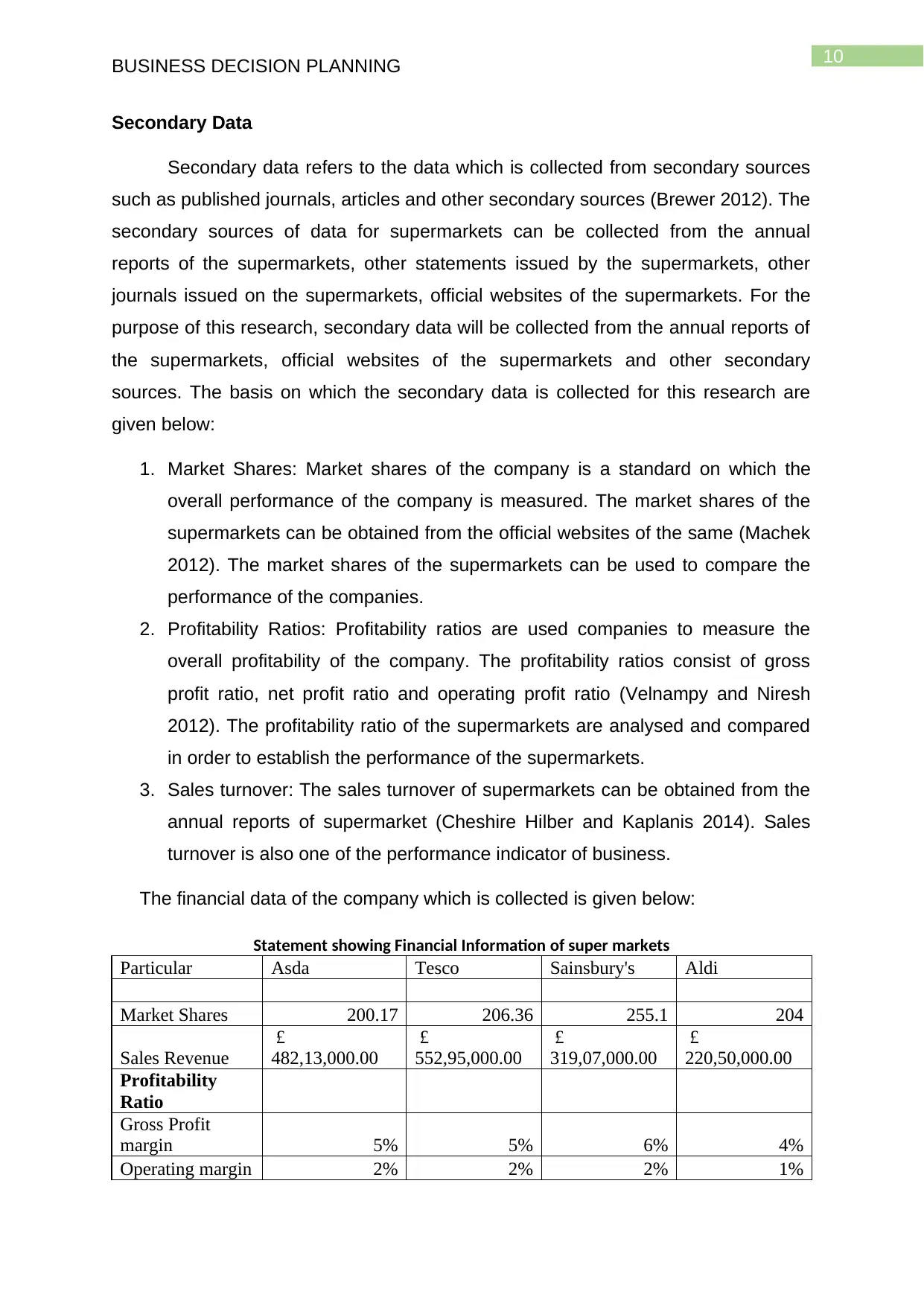
10
BUSINESS DECISION PLANNING
Secondary Data
Secondary data refers to the data which is collected from secondary sources
such as published journals, articles and other secondary sources (Brewer 2012). The
secondary sources of data for supermarkets can be collected from the annual
reports of the supermarkets, other statements issued by the supermarkets, other
journals issued on the supermarkets, official websites of the supermarkets. For the
purpose of this research, secondary data will be collected from the annual reports of
the supermarkets, official websites of the supermarkets and other secondary
sources. The basis on which the secondary data is collected for this research are
given below:
1. Market Shares: Market shares of the company is a standard on which the
overall performance of the company is measured. The market shares of the
supermarkets can be obtained from the official websites of the same (Machek
2012). The market shares of the supermarkets can be used to compare the
performance of the companies.
2. Profitability Ratios: Profitability ratios are used companies to measure the
overall profitability of the company. The profitability ratios consist of gross
profit ratio, net profit ratio and operating profit ratio (Velnampy and Niresh
2012). The profitability ratio of the supermarkets are analysed and compared
in order to establish the performance of the supermarkets.
3. Sales turnover: The sales turnover of supermarkets can be obtained from the
annual reports of supermarket (Cheshire Hilber and Kaplanis 2014). Sales
turnover is also one of the performance indicator of business.
The financial data of the company which is collected is given below:
Statement showing Financial Information of super markets
Particular Asda Tesco Sainsbury's Aldi
Market Shares 200.17 206.36 255.1 204
Sales Revenue
£
482,13,000.00
£
552,95,000.00
£
319,07,000.00
£
220,50,000.00
Profitability
Ratio
Gross Profit
margin 5% 5% 6% 4%
Operating margin 2% 2% 2% 1%
BUSINESS DECISION PLANNING
Secondary Data
Secondary data refers to the data which is collected from secondary sources
such as published journals, articles and other secondary sources (Brewer 2012). The
secondary sources of data for supermarkets can be collected from the annual
reports of the supermarkets, other statements issued by the supermarkets, other
journals issued on the supermarkets, official websites of the supermarkets. For the
purpose of this research, secondary data will be collected from the annual reports of
the supermarkets, official websites of the supermarkets and other secondary
sources. The basis on which the secondary data is collected for this research are
given below:
1. Market Shares: Market shares of the company is a standard on which the
overall performance of the company is measured. The market shares of the
supermarkets can be obtained from the official websites of the same (Machek
2012). The market shares of the supermarkets can be used to compare the
performance of the companies.
2. Profitability Ratios: Profitability ratios are used companies to measure the
overall profitability of the company. The profitability ratios consist of gross
profit ratio, net profit ratio and operating profit ratio (Velnampy and Niresh
2012). The profitability ratio of the supermarkets are analysed and compared
in order to establish the performance of the supermarkets.
3. Sales turnover: The sales turnover of supermarkets can be obtained from the
annual reports of supermarket (Cheshire Hilber and Kaplanis 2014). Sales
turnover is also one of the performance indicator of business.
The financial data of the company which is collected is given below:
Statement showing Financial Information of super markets
Particular Asda Tesco Sainsbury's Aldi
Market Shares 200.17 206.36 255.1 204
Sales Revenue
£
482,13,000.00
£
552,95,000.00
£
319,07,000.00
£
220,50,000.00
Profitability
Ratio
Gross Profit
margin 5% 5% 6% 4%
Operating margin 2% 2% 2% 1%

11
BUSINESS DECISION PLANNING
Net Profit margin 2% -1% 1% 1%
The above table shows the comparison between the financial information of
successful supermarkets chains like Asda, Tesco Plc, Sainsbury’s and Aldi which
operates in the market of United Kingdom. The market shares of the company show
that Sainsbury’s supermarkets enjoy a higher value in market shares as compared to
Tesco, Aldi and Asda supermarket shares. The market shares of the Sainsbury’s as
shown in the above table is 255.10 c which shows that the supermarket chain is
performing better in terms of market shares as compared to its rival Supermarket
chains. The market shares of Tesco, Aldi and Asda are more or less in the same
range which signifies that there is intense competition among the supermarkets for
market dominance. Asda and Aldi Super markets in order to get even with its rivals
Tesco and Sainsbury’s is applying all the strategies which can have impact on the
profitability and market shares of the company. The profitability ratios which include
gross profit margin, net profit margin and operating profit margin also show that the
same results when comparison is made in respect of all supermarkets. However, the
sales revenue of Tesco supermarkets is much more than Sainsbury’s, Asda and Aldi
which is evidence that the supermarket is popular among the customers and the
customers prefer Tesco markets for one stop destination shopping.
Asda Tesco Sainsbury's Aldi
0
50
100
150
200
250
300
Market Shares
Figure1: (Chart showing Market shares of supermarkets)
Source: (Created by the Author)
BUSINESS DECISION PLANNING
Net Profit margin 2% -1% 1% 1%
The above table shows the comparison between the financial information of
successful supermarkets chains like Asda, Tesco Plc, Sainsbury’s and Aldi which
operates in the market of United Kingdom. The market shares of the company show
that Sainsbury’s supermarkets enjoy a higher value in market shares as compared to
Tesco, Aldi and Asda supermarket shares. The market shares of the Sainsbury’s as
shown in the above table is 255.10 c which shows that the supermarket chain is
performing better in terms of market shares as compared to its rival Supermarket
chains. The market shares of Tesco, Aldi and Asda are more or less in the same
range which signifies that there is intense competition among the supermarkets for
market dominance. Asda and Aldi Super markets in order to get even with its rivals
Tesco and Sainsbury’s is applying all the strategies which can have impact on the
profitability and market shares of the company. The profitability ratios which include
gross profit margin, net profit margin and operating profit margin also show that the
same results when comparison is made in respect of all supermarkets. However, the
sales revenue of Tesco supermarkets is much more than Sainsbury’s, Asda and Aldi
which is evidence that the supermarket is popular among the customers and the
customers prefer Tesco markets for one stop destination shopping.
Asda Tesco Sainsbury's Aldi
0
50
100
150
200
250
300
Market Shares
Figure1: (Chart showing Market shares of supermarkets)
Source: (Created by the Author)
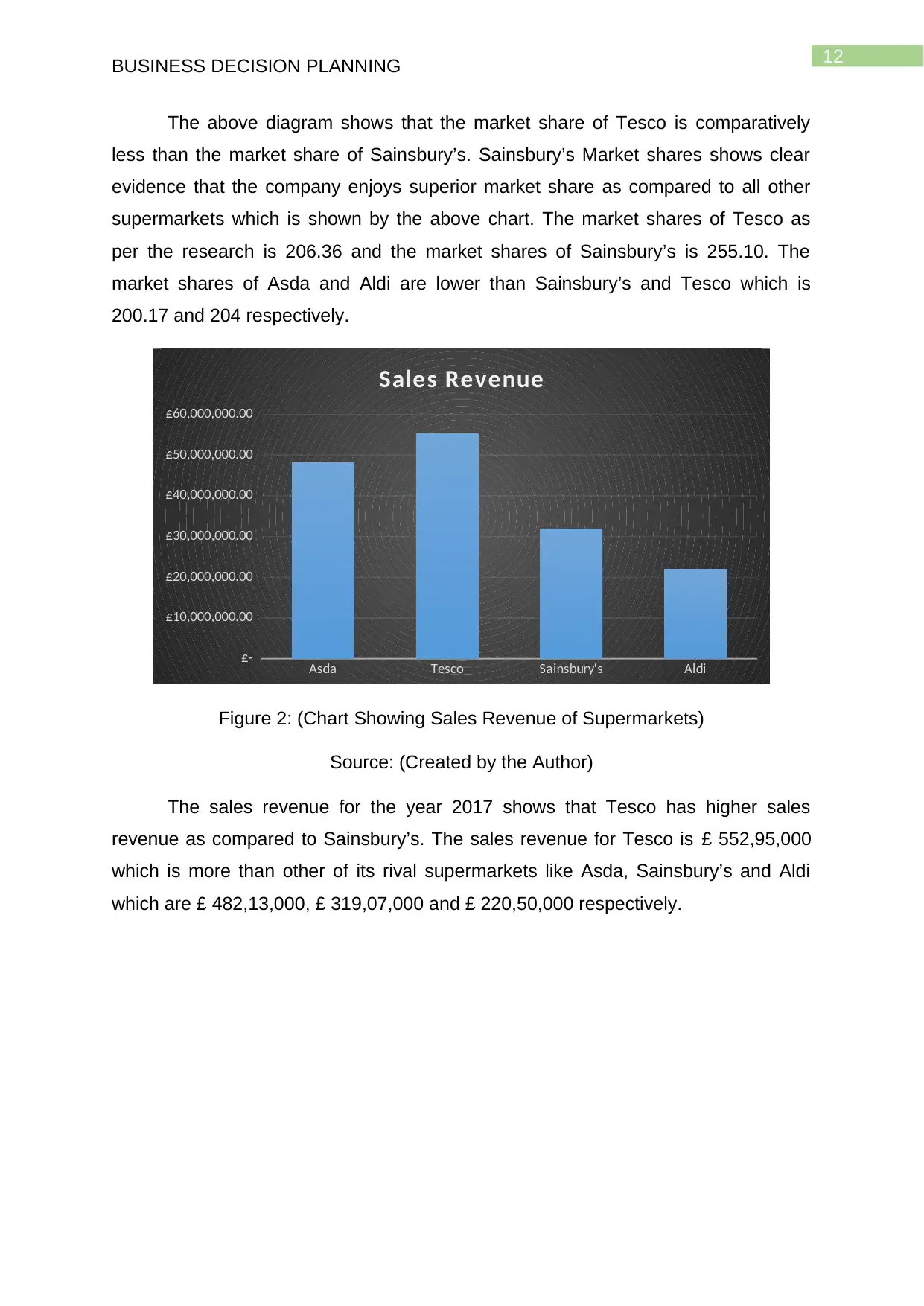
12
BUSINESS DECISION PLANNING
The above diagram shows that the market share of Tesco is comparatively
less than the market share of Sainsbury’s. Sainsbury’s Market shares shows clear
evidence that the company enjoys superior market share as compared to all other
supermarkets which is shown by the above chart. The market shares of Tesco as
per the research is 206.36 and the market shares of Sainsbury’s is 255.10. The
market shares of Asda and Aldi are lower than Sainsbury’s and Tesco which is
200.17 and 204 respectively.
Asda Tesco Sainsbury's Aldi
£-
£10,000,000.00
£20,000,000.00
£30,000,000.00
£40,000,000.00
£50,000,000.00
£60,000,000.00
Sales Revenue
Figure 2: (Chart Showing Sales Revenue of Supermarkets)
Source: (Created by the Author)
The sales revenue for the year 2017 shows that Tesco has higher sales
revenue as compared to Sainsbury’s. The sales revenue for Tesco is £ 552,95,000
which is more than other of its rival supermarkets like Asda, Sainsbury’s and Aldi
which are £ 482,13,000, £ 319,07,000 and £ 220,50,000 respectively.
BUSINESS DECISION PLANNING
The above diagram shows that the market share of Tesco is comparatively
less than the market share of Sainsbury’s. Sainsbury’s Market shares shows clear
evidence that the company enjoys superior market share as compared to all other
supermarkets which is shown by the above chart. The market shares of Tesco as
per the research is 206.36 and the market shares of Sainsbury’s is 255.10. The
market shares of Asda and Aldi are lower than Sainsbury’s and Tesco which is
200.17 and 204 respectively.
Asda Tesco Sainsbury's Aldi
£-
£10,000,000.00
£20,000,000.00
£30,000,000.00
£40,000,000.00
£50,000,000.00
£60,000,000.00
Sales Revenue
Figure 2: (Chart Showing Sales Revenue of Supermarkets)
Source: (Created by the Author)
The sales revenue for the year 2017 shows that Tesco has higher sales
revenue as compared to Sainsbury’s. The sales revenue for Tesco is £ 552,95,000
which is more than other of its rival supermarkets like Asda, Sainsbury’s and Aldi
which are £ 482,13,000, £ 319,07,000 and £ 220,50,000 respectively.
Paraphrase This Document
Need a fresh take? Get an instant paraphrase of this document with our AI Paraphraser
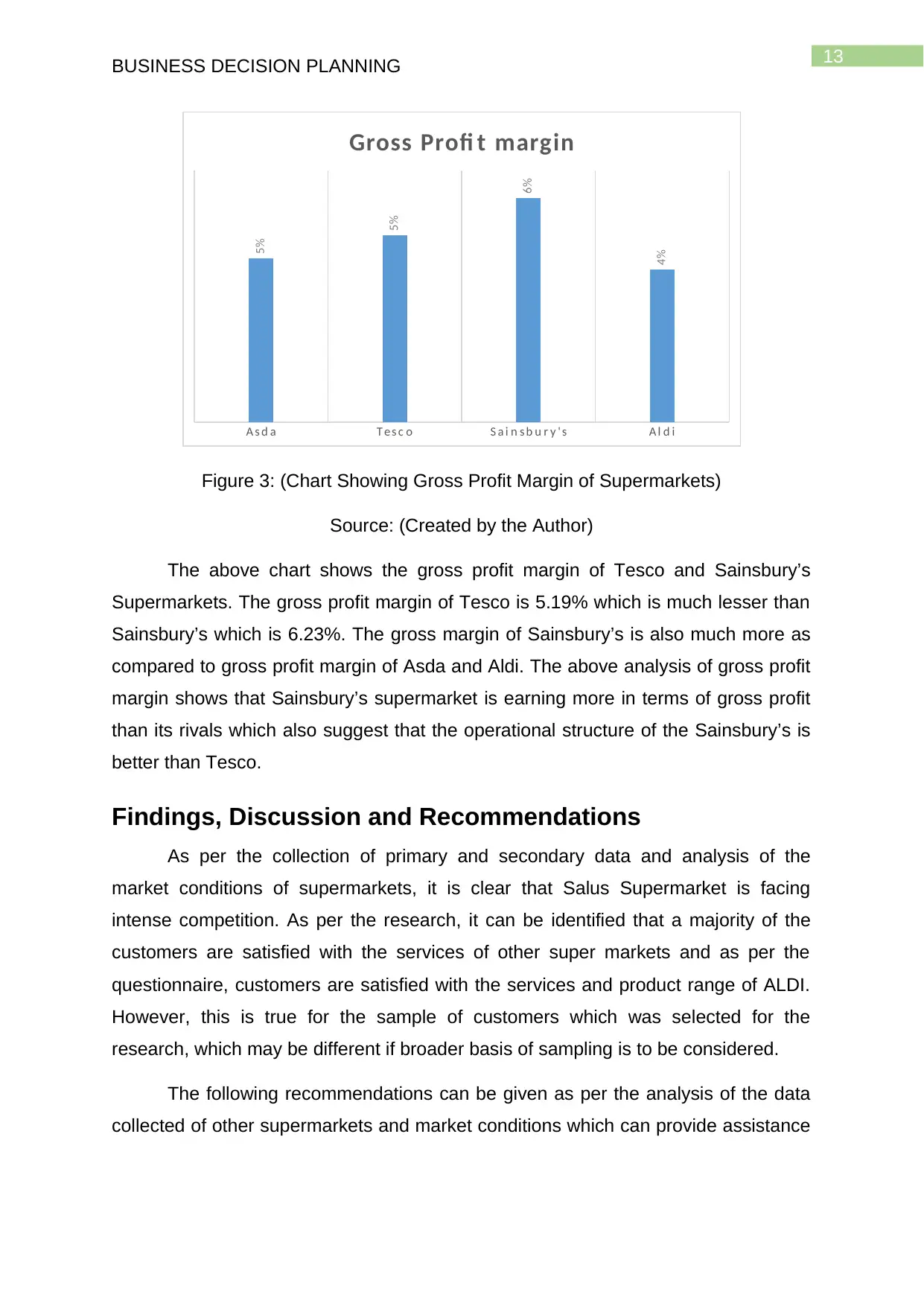
13
BUSINESS DECISION PLANNING
A s d a T e s c o S a i n s b u r y ' s A l d i
5%
5%
6%
4%
Gross Profi t margin
Figure 3: (Chart Showing Gross Profit Margin of Supermarkets)
Source: (Created by the Author)
The above chart shows the gross profit margin of Tesco and Sainsbury’s
Supermarkets. The gross profit margin of Tesco is 5.19% which is much lesser than
Sainsbury’s which is 6.23%. The gross margin of Sainsbury’s is also much more as
compared to gross profit margin of Asda and Aldi. The above analysis of gross profit
margin shows that Sainsbury’s supermarket is earning more in terms of gross profit
than its rivals which also suggest that the operational structure of the Sainsbury’s is
better than Tesco.
Findings, Discussion and Recommendations
As per the collection of primary and secondary data and analysis of the
market conditions of supermarkets, it is clear that Salus Supermarket is facing
intense competition. As per the research, it can be identified that a majority of the
customers are satisfied with the services of other super markets and as per the
questionnaire, customers are satisfied with the services and product range of ALDI.
However, this is true for the sample of customers which was selected for the
research, which may be different if broader basis of sampling is to be considered.
The following recommendations can be given as per the analysis of the data
collected of other supermarkets and market conditions which can provide assistance
BUSINESS DECISION PLANNING
A s d a T e s c o S a i n s b u r y ' s A l d i
5%
5%
6%
4%
Gross Profi t margin
Figure 3: (Chart Showing Gross Profit Margin of Supermarkets)
Source: (Created by the Author)
The above chart shows the gross profit margin of Tesco and Sainsbury’s
Supermarkets. The gross profit margin of Tesco is 5.19% which is much lesser than
Sainsbury’s which is 6.23%. The gross margin of Sainsbury’s is also much more as
compared to gross profit margin of Asda and Aldi. The above analysis of gross profit
margin shows that Sainsbury’s supermarket is earning more in terms of gross profit
than its rivals which also suggest that the operational structure of the Sainsbury’s is
better than Tesco.
Findings, Discussion and Recommendations
As per the collection of primary and secondary data and analysis of the
market conditions of supermarkets, it is clear that Salus Supermarket is facing
intense competition. As per the research, it can be identified that a majority of the
customers are satisfied with the services of other super markets and as per the
questionnaire, customers are satisfied with the services and product range of ALDI.
However, this is true for the sample of customers which was selected for the
research, which may be different if broader basis of sampling is to be considered.
The following recommendations can be given as per the analysis of the data
collected of other supermarkets and market conditions which can provide assistance
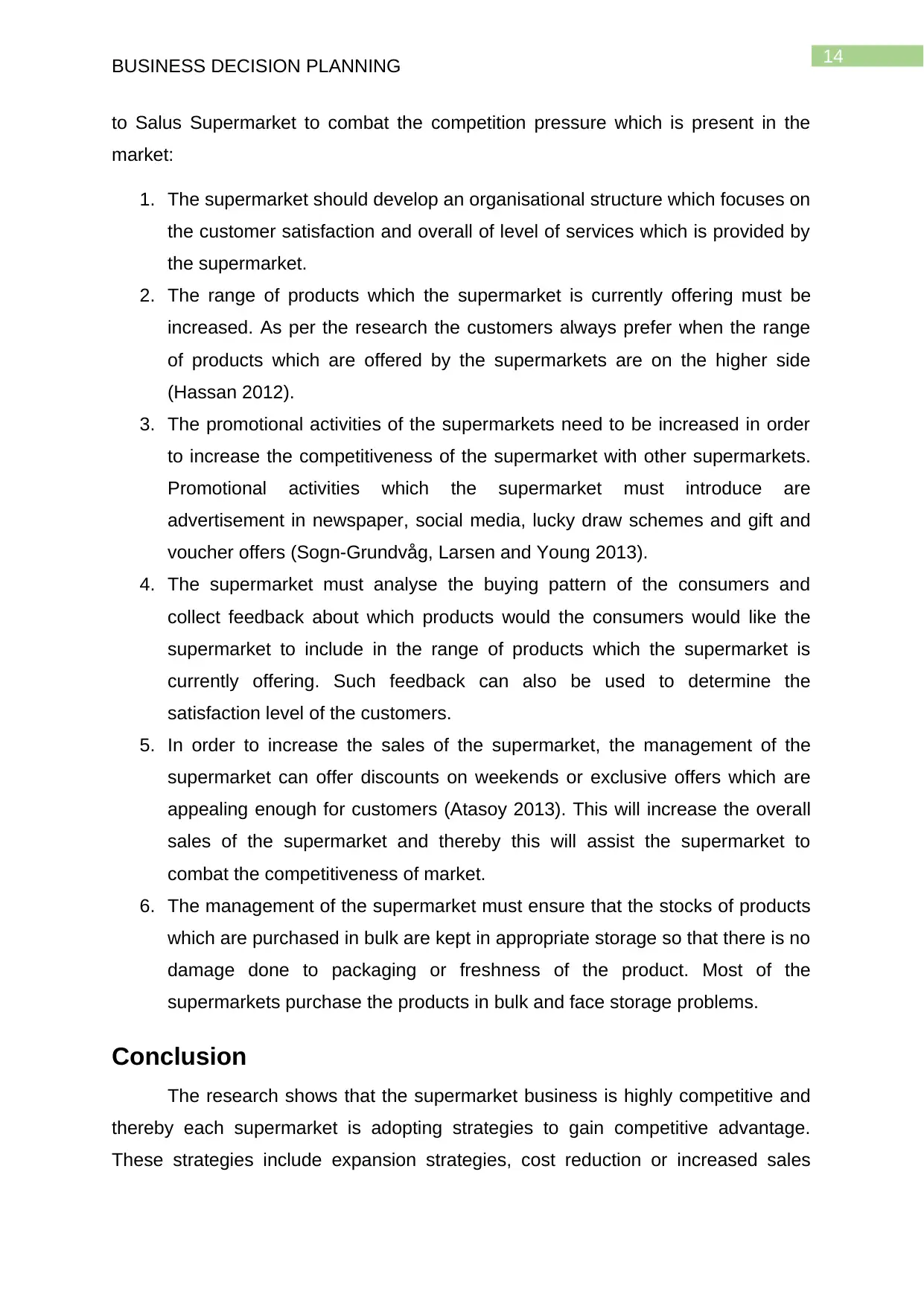
14
BUSINESS DECISION PLANNING
to Salus Supermarket to combat the competition pressure which is present in the
market:
1. The supermarket should develop an organisational structure which focuses on
the customer satisfaction and overall of level of services which is provided by
the supermarket.
2. The range of products which the supermarket is currently offering must be
increased. As per the research the customers always prefer when the range
of products which are offered by the supermarkets are on the higher side
(Hassan 2012).
3. The promotional activities of the supermarkets need to be increased in order
to increase the competitiveness of the supermarket with other supermarkets.
Promotional activities which the supermarket must introduce are
advertisement in newspaper, social media, lucky draw schemes and gift and
voucher offers (Sogn-Grundvåg, Larsen and Young 2013).
4. The supermarket must analyse the buying pattern of the consumers and
collect feedback about which products would the consumers would like the
supermarket to include in the range of products which the supermarket is
currently offering. Such feedback can also be used to determine the
satisfaction level of the customers.
5. In order to increase the sales of the supermarket, the management of the
supermarket can offer discounts on weekends or exclusive offers which are
appealing enough for customers (Atasoy 2013). This will increase the overall
sales of the supermarket and thereby this will assist the supermarket to
combat the competitiveness of market.
6. The management of the supermarket must ensure that the stocks of products
which are purchased in bulk are kept in appropriate storage so that there is no
damage done to packaging or freshness of the product. Most of the
supermarkets purchase the products in bulk and face storage problems.
Conclusion
The research shows that the supermarket business is highly competitive and
thereby each supermarket is adopting strategies to gain competitive advantage.
These strategies include expansion strategies, cost reduction or increased sales
BUSINESS DECISION PLANNING
to Salus Supermarket to combat the competition pressure which is present in the
market:
1. The supermarket should develop an organisational structure which focuses on
the customer satisfaction and overall of level of services which is provided by
the supermarket.
2. The range of products which the supermarket is currently offering must be
increased. As per the research the customers always prefer when the range
of products which are offered by the supermarkets are on the higher side
(Hassan 2012).
3. The promotional activities of the supermarkets need to be increased in order
to increase the competitiveness of the supermarket with other supermarkets.
Promotional activities which the supermarket must introduce are
advertisement in newspaper, social media, lucky draw schemes and gift and
voucher offers (Sogn-Grundvåg, Larsen and Young 2013).
4. The supermarket must analyse the buying pattern of the consumers and
collect feedback about which products would the consumers would like the
supermarket to include in the range of products which the supermarket is
currently offering. Such feedback can also be used to determine the
satisfaction level of the customers.
5. In order to increase the sales of the supermarket, the management of the
supermarket can offer discounts on weekends or exclusive offers which are
appealing enough for customers (Atasoy 2013). This will increase the overall
sales of the supermarket and thereby this will assist the supermarket to
combat the competitiveness of market.
6. The management of the supermarket must ensure that the stocks of products
which are purchased in bulk are kept in appropriate storage so that there is no
damage done to packaging or freshness of the product. Most of the
supermarkets purchase the products in bulk and face storage problems.
Conclusion
The research shows that the supermarket business is highly competitive and
thereby each supermarket is adopting strategies to gain competitive advantage.
These strategies include expansion strategies, cost reduction or increased sales

15
BUSINESS DECISION PLANNING
strategies. In this case, Salus Supermarkets can increase the sales or reduce the
cost of the supermarket in order to gain competitive advantage. The research shows
that other supermarkets which are operating in the region have decent amount of
sales turnover and gross profit margin. The research identifies buying patterns of
customers, satisfaction level of customers and the range of products and sale
services which the supermarket is offering.
Reference
Aloysius, G. and Binu, D., 2013. An approach to products placement in
supermarkets using PrefixSpan algorithm. Journal of King Saud University-
Computer and Information Sciences, 25(1), pp.77-87.
Atasoy, Y., 2013. Supermarket expansion in Turkey: Shifting relations of food
provisioning. Journal of Agrarian Change, 13(4), pp.547-570.
Brewer, E.W., 2012. Secondary data analysis. Sage secondary data analysis,
pp.165-176.
Busk, P.L. and Marascuilo, L.A., 2015. Statistical analysis in single-case
research. Single-Case Research Design and Analysis (Psychology Revivals): New
Directions for Psychology and Education, p.159.
Cameron, A.J., Charlton, E., Ngan, W.W. and Sacks, G., 2016. A systematic review
of the effectiveness of supermarket-based interventions involving product,
promotion, or place on the healthiness of consumer purchases. Current Nutrition
Reports, 5(3), pp.129-138.
BUSINESS DECISION PLANNING
strategies. In this case, Salus Supermarkets can increase the sales or reduce the
cost of the supermarket in order to gain competitive advantage. The research shows
that other supermarkets which are operating in the region have decent amount of
sales turnover and gross profit margin. The research identifies buying patterns of
customers, satisfaction level of customers and the range of products and sale
services which the supermarket is offering.
Reference
Aloysius, G. and Binu, D., 2013. An approach to products placement in
supermarkets using PrefixSpan algorithm. Journal of King Saud University-
Computer and Information Sciences, 25(1), pp.77-87.
Atasoy, Y., 2013. Supermarket expansion in Turkey: Shifting relations of food
provisioning. Journal of Agrarian Change, 13(4), pp.547-570.
Brewer, E.W., 2012. Secondary data analysis. Sage secondary data analysis,
pp.165-176.
Busk, P.L. and Marascuilo, L.A., 2015. Statistical analysis in single-case
research. Single-Case Research Design and Analysis (Psychology Revivals): New
Directions for Psychology and Education, p.159.
Cameron, A.J., Charlton, E., Ngan, W.W. and Sacks, G., 2016. A systematic review
of the effectiveness of supermarket-based interventions involving product,
promotion, or place on the healthiness of consumer purchases. Current Nutrition
Reports, 5(3), pp.129-138.
Secure Best Marks with AI Grader
Need help grading? Try our AI Grader for instant feedback on your assignments.

16
BUSINESS DECISION PLANNING
Cheshire, P.C., Hilber, C.A. and Kaplanis, I., 2014. Land use regulation and
productivity—land matters: evidence from a UK supermarket chain. Journal of
Economic Geography, 15(1), pp.43-73.
Ellickson, P.B., 2016. 15 the evolution of the supermarket industry: from a&P to
Walmart1. Handbook on the Economics of Retailing and Distribution, p.368.
Epstein, L.H., Jankowiak, N., Nederkoorn, C., Raynor, H.A., French, S.A. and
Finkelstein, E., 2012. Experimental research on the relation between food price
changes and food-purchasing patterns: a targeted review–. The American journal of
clinical nutrition, 95(4), pp.789-809.
Guest, G., Namey, E.E. and Mitchell, M.L., 2012. Collecting qualitative data: A field
manual for applied research. Sage.
Hassan, A., 2012. The value proposition concept in marketing: How customers
perceive the value delivered by firms–A study of customer perspectives on
supermarkets in Southampton in the United Kingdom. International journal of
marketing studies, 4(3), p.68.
Hippler, H.J., Schwarz, N. and Sudman, S. eds., 2012. Social information processing
and survey methodology. Springer Science & Business Media.
Hox, J.J. and Boeije, H.R., 2005. Data collection, primary versus secondary.
Lewis, S., 2015. Qualitative inquiry and research design: Choosing among five
approaches. Health promotion practice, 16(4), pp.473-475.
Machek, M., 2012. Retail market structure development in Central Europe. Central
European business review, 1(3), p.22.
Marshall, B., Cardon, P., Poddar, A. and Fontenot, R., 2013. Does sample size
matter in qualitative research?: A review of qualitative interviews in IS
research. Journal of Computer Information Systems, 54(1), pp.11-22.
Merriam, S.B. and Tisdell, E.J., 2015. Qualitative research: A guide to design and
implementation. John Wiley & Sons.
Neuman, W.L., 2013. Social research methods: Qualitative and quantitative
approaches. Pearson education.
BUSINESS DECISION PLANNING
Cheshire, P.C., Hilber, C.A. and Kaplanis, I., 2014. Land use regulation and
productivity—land matters: evidence from a UK supermarket chain. Journal of
Economic Geography, 15(1), pp.43-73.
Ellickson, P.B., 2016. 15 the evolution of the supermarket industry: from a&P to
Walmart1. Handbook on the Economics of Retailing and Distribution, p.368.
Epstein, L.H., Jankowiak, N., Nederkoorn, C., Raynor, H.A., French, S.A. and
Finkelstein, E., 2012. Experimental research on the relation between food price
changes and food-purchasing patterns: a targeted review–. The American journal of
clinical nutrition, 95(4), pp.789-809.
Guest, G., Namey, E.E. and Mitchell, M.L., 2012. Collecting qualitative data: A field
manual for applied research. Sage.
Hassan, A., 2012. The value proposition concept in marketing: How customers
perceive the value delivered by firms–A study of customer perspectives on
supermarkets in Southampton in the United Kingdom. International journal of
marketing studies, 4(3), p.68.
Hippler, H.J., Schwarz, N. and Sudman, S. eds., 2012. Social information processing
and survey methodology. Springer Science & Business Media.
Hox, J.J. and Boeije, H.R., 2005. Data collection, primary versus secondary.
Lewis, S., 2015. Qualitative inquiry and research design: Choosing among five
approaches. Health promotion practice, 16(4), pp.473-475.
Machek, M., 2012. Retail market structure development in Central Europe. Central
European business review, 1(3), p.22.
Marshall, B., Cardon, P., Poddar, A. and Fontenot, R., 2013. Does sample size
matter in qualitative research?: A review of qualitative interviews in IS
research. Journal of Computer Information Systems, 54(1), pp.11-22.
Merriam, S.B. and Tisdell, E.J., 2015. Qualitative research: A guide to design and
implementation. John Wiley & Sons.
Neuman, W.L., 2013. Social research methods: Qualitative and quantitative
approaches. Pearson education.
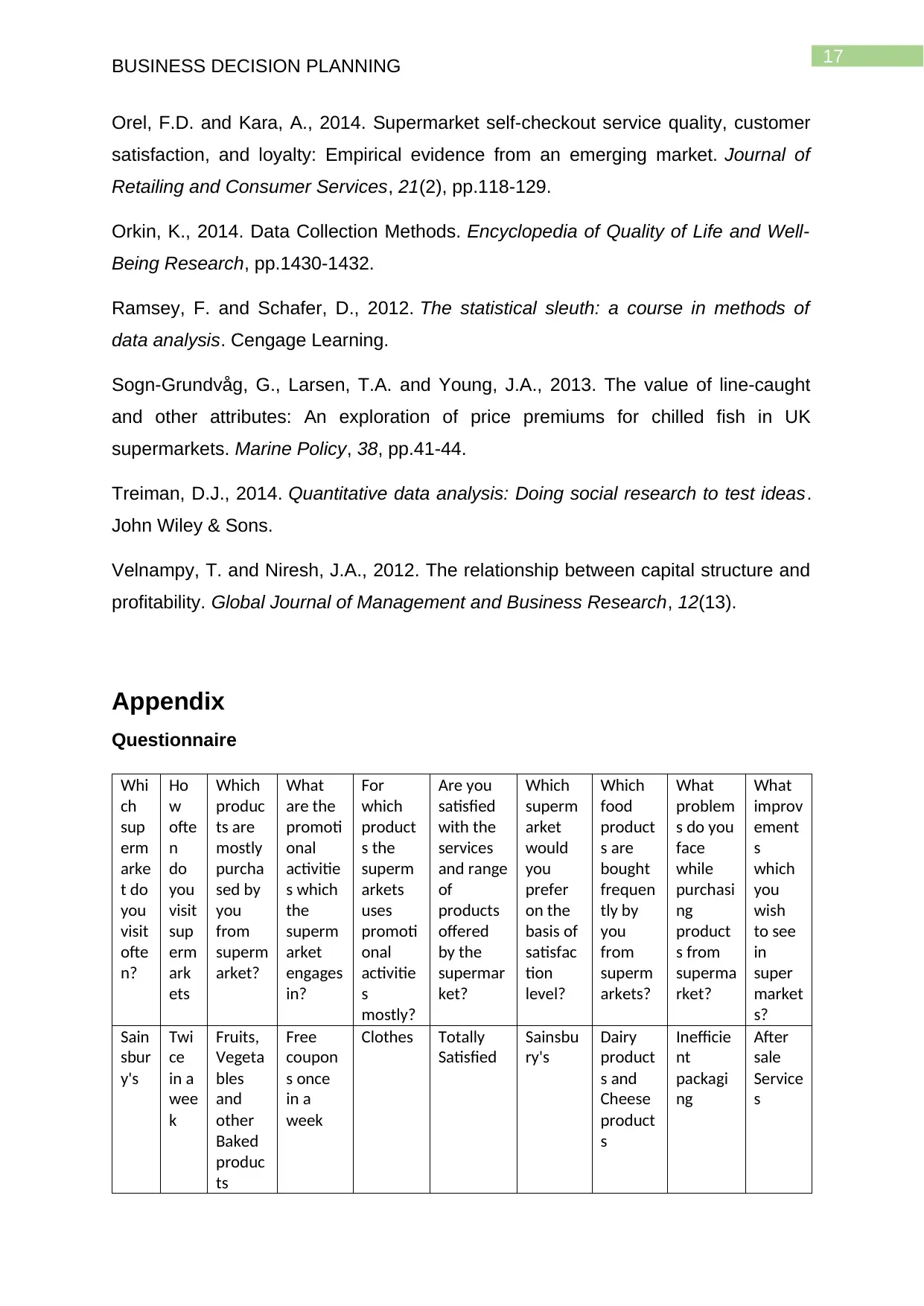
17
BUSINESS DECISION PLANNING
Orel, F.D. and Kara, A., 2014. Supermarket self-checkout service quality, customer
satisfaction, and loyalty: Empirical evidence from an emerging market. Journal of
Retailing and Consumer Services, 21(2), pp.118-129.
Orkin, K., 2014. Data Collection Methods. Encyclopedia of Quality of Life and Well-
Being Research, pp.1430-1432.
Ramsey, F. and Schafer, D., 2012. The statistical sleuth: a course in methods of
data analysis. Cengage Learning.
Sogn-Grundvåg, G., Larsen, T.A. and Young, J.A., 2013. The value of line-caught
and other attributes: An exploration of price premiums for chilled fish in UK
supermarkets. Marine Policy, 38, pp.41-44.
Treiman, D.J., 2014. Quantitative data analysis: Doing social research to test ideas.
John Wiley & Sons.
Velnampy, T. and Niresh, J.A., 2012. The relationship between capital structure and
profitability. Global Journal of Management and Business Research, 12(13).
Appendix
Questionnaire
Whi
ch
sup
erm
arke
t do
you
visit
ofte
n?
Ho
w
ofte
n
do
you
visit
sup
erm
ark
ets
Which
produc
ts are
mostly
purcha
sed by
you
from
superm
arket?
What
are the
promoti
onal
activitie
s which
the
superm
arket
engages
in?
For
which
product
s the
superm
arkets
uses
promoti
onal
activitie
s
mostly?
Are you
satisfied
with the
services
and range
of
products
offered
by the
supermar
ket?
Which
superm
arket
would
you
prefer
on the
basis of
satisfac
tion
level?
Which
food
product
s are
bought
frequen
tly by
you
from
superm
arkets?
What
problem
s do you
face
while
purchasi
ng
product
s from
superma
rket?
What
improv
ement
s
which
you
wish
to see
in
super
market
s?
Sain
sbur
y's
Twi
ce
in a
wee
k
Fruits,
Vegeta
bles
and
other
Baked
produc
ts
Free
coupon
s once
in a
week
Clothes Totally
Satisfied
Sainsbu
ry's
Dairy
product
s and
Cheese
product
s
Inefficie
nt
packagi
ng
After
sale
Service
s
BUSINESS DECISION PLANNING
Orel, F.D. and Kara, A., 2014. Supermarket self-checkout service quality, customer
satisfaction, and loyalty: Empirical evidence from an emerging market. Journal of
Retailing and Consumer Services, 21(2), pp.118-129.
Orkin, K., 2014. Data Collection Methods. Encyclopedia of Quality of Life and Well-
Being Research, pp.1430-1432.
Ramsey, F. and Schafer, D., 2012. The statistical sleuth: a course in methods of
data analysis. Cengage Learning.
Sogn-Grundvåg, G., Larsen, T.A. and Young, J.A., 2013. The value of line-caught
and other attributes: An exploration of price premiums for chilled fish in UK
supermarkets. Marine Policy, 38, pp.41-44.
Treiman, D.J., 2014. Quantitative data analysis: Doing social research to test ideas.
John Wiley & Sons.
Velnampy, T. and Niresh, J.A., 2012. The relationship between capital structure and
profitability. Global Journal of Management and Business Research, 12(13).
Appendix
Questionnaire
Whi
ch
sup
erm
arke
t do
you
visit
ofte
n?
Ho
w
ofte
n
do
you
visit
sup
erm
ark
ets
Which
produc
ts are
mostly
purcha
sed by
you
from
superm
arket?
What
are the
promoti
onal
activitie
s which
the
superm
arket
engages
in?
For
which
product
s the
superm
arkets
uses
promoti
onal
activitie
s
mostly?
Are you
satisfied
with the
services
and range
of
products
offered
by the
supermar
ket?
Which
superm
arket
would
you
prefer
on the
basis of
satisfac
tion
level?
Which
food
product
s are
bought
frequen
tly by
you
from
superm
arkets?
What
problem
s do you
face
while
purchasi
ng
product
s from
superma
rket?
What
improv
ement
s
which
you
wish
to see
in
super
market
s?
Sain
sbur
y's
Twi
ce
in a
wee
k
Fruits,
Vegeta
bles
and
other
Baked
produc
ts
Free
coupon
s once
in a
week
Clothes Totally
Satisfied
Sainsbu
ry's
Dairy
product
s and
Cheese
product
s
Inefficie
nt
packagi
ng
After
sale
Service
s
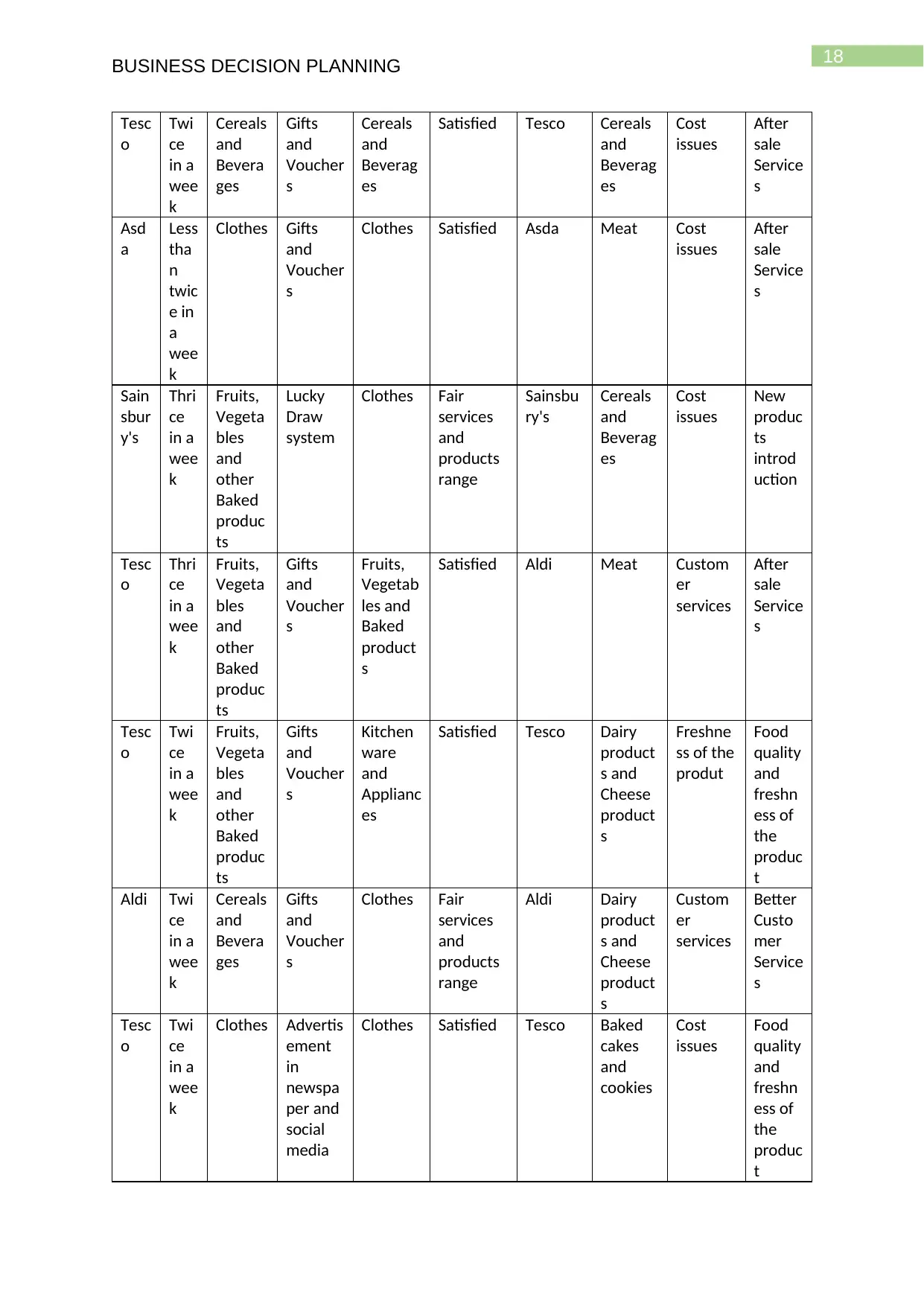
18
BUSINESS DECISION PLANNING
Tesc
o
Twi
ce
in a
wee
k
Cereals
and
Bevera
ges
Gifts
and
Voucher
s
Cereals
and
Beverag
es
Satisfied Tesco Cereals
and
Beverag
es
Cost
issues
After
sale
Service
s
Asd
a
Less
tha
n
twic
e in
a
wee
k
Clothes Gifts
and
Voucher
s
Clothes Satisfied Asda Meat Cost
issues
After
sale
Service
s
Sain
sbur
y's
Thri
ce
in a
wee
k
Fruits,
Vegeta
bles
and
other
Baked
produc
ts
Lucky
Draw
system
Clothes Fair
services
and
products
range
Sainsbu
ry's
Cereals
and
Beverag
es
Cost
issues
New
produc
ts
introd
uction
Tesc
o
Thri
ce
in a
wee
k
Fruits,
Vegeta
bles
and
other
Baked
produc
ts
Gifts
and
Voucher
s
Fruits,
Vegetab
les and
Baked
product
s
Satisfied Aldi Meat Custom
er
services
After
sale
Service
s
Tesc
o
Twi
ce
in a
wee
k
Fruits,
Vegeta
bles
and
other
Baked
produc
ts
Gifts
and
Voucher
s
Kitchen
ware
and
Applianc
es
Satisfied Tesco Dairy
product
s and
Cheese
product
s
Freshne
ss of the
produt
Food
quality
and
freshn
ess of
the
produc
t
Aldi Twi
ce
in a
wee
k
Cereals
and
Bevera
ges
Gifts
and
Voucher
s
Clothes Fair
services
and
products
range
Aldi Dairy
product
s and
Cheese
product
s
Custom
er
services
Better
Custo
mer
Service
s
Tesc
o
Twi
ce
in a
wee
k
Clothes Advertis
ement
in
newspa
per and
social
media
Clothes Satisfied Tesco Baked
cakes
and
cookies
Cost
issues
Food
quality
and
freshn
ess of
the
produc
t
BUSINESS DECISION PLANNING
Tesc
o
Twi
ce
in a
wee
k
Cereals
and
Bevera
ges
Gifts
and
Voucher
s
Cereals
and
Beverag
es
Satisfied Tesco Cereals
and
Beverag
es
Cost
issues
After
sale
Service
s
Asd
a
Less
tha
n
twic
e in
a
wee
k
Clothes Gifts
and
Voucher
s
Clothes Satisfied Asda Meat Cost
issues
After
sale
Service
s
Sain
sbur
y's
Thri
ce
in a
wee
k
Fruits,
Vegeta
bles
and
other
Baked
produc
ts
Lucky
Draw
system
Clothes Fair
services
and
products
range
Sainsbu
ry's
Cereals
and
Beverag
es
Cost
issues
New
produc
ts
introd
uction
Tesc
o
Thri
ce
in a
wee
k
Fruits,
Vegeta
bles
and
other
Baked
produc
ts
Gifts
and
Voucher
s
Fruits,
Vegetab
les and
Baked
product
s
Satisfied Aldi Meat Custom
er
services
After
sale
Service
s
Tesc
o
Twi
ce
in a
wee
k
Fruits,
Vegeta
bles
and
other
Baked
produc
ts
Gifts
and
Voucher
s
Kitchen
ware
and
Applianc
es
Satisfied Tesco Dairy
product
s and
Cheese
product
s
Freshne
ss of the
produt
Food
quality
and
freshn
ess of
the
produc
t
Aldi Twi
ce
in a
wee
k
Cereals
and
Bevera
ges
Gifts
and
Voucher
s
Clothes Fair
services
and
products
range
Aldi Dairy
product
s and
Cheese
product
s
Custom
er
services
Better
Custo
mer
Service
s
Tesc
o
Twi
ce
in a
wee
k
Clothes Advertis
ement
in
newspa
per and
social
media
Clothes Satisfied Tesco Baked
cakes
and
cookies
Cost
issues
Food
quality
and
freshn
ess of
the
produc
t
Paraphrase This Document
Need a fresh take? Get an instant paraphrase of this document with our AI Paraphraser
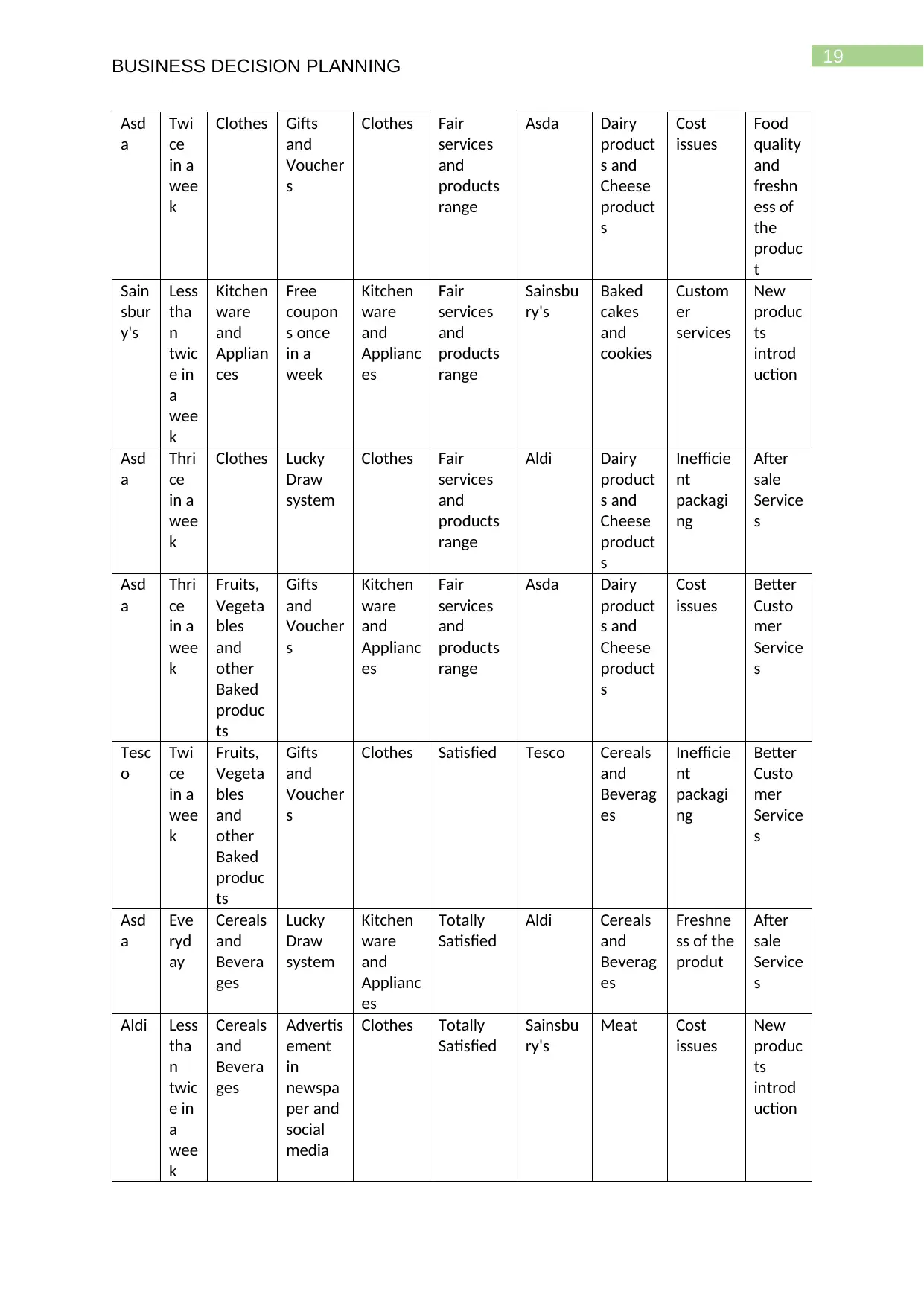
19
BUSINESS DECISION PLANNING
Asd
a
Twi
ce
in a
wee
k
Clothes Gifts
and
Voucher
s
Clothes Fair
services
and
products
range
Asda Dairy
product
s and
Cheese
product
s
Cost
issues
Food
quality
and
freshn
ess of
the
produc
t
Sain
sbur
y's
Less
tha
n
twic
e in
a
wee
k
Kitchen
ware
and
Applian
ces
Free
coupon
s once
in a
week
Kitchen
ware
and
Applianc
es
Fair
services
and
products
range
Sainsbu
ry's
Baked
cakes
and
cookies
Custom
er
services
New
produc
ts
introd
uction
Asd
a
Thri
ce
in a
wee
k
Clothes Lucky
Draw
system
Clothes Fair
services
and
products
range
Aldi Dairy
product
s and
Cheese
product
s
Inefficie
nt
packagi
ng
After
sale
Service
s
Asd
a
Thri
ce
in a
wee
k
Fruits,
Vegeta
bles
and
other
Baked
produc
ts
Gifts
and
Voucher
s
Kitchen
ware
and
Applianc
es
Fair
services
and
products
range
Asda Dairy
product
s and
Cheese
product
s
Cost
issues
Better
Custo
mer
Service
s
Tesc
o
Twi
ce
in a
wee
k
Fruits,
Vegeta
bles
and
other
Baked
produc
ts
Gifts
and
Voucher
s
Clothes Satisfied Tesco Cereals
and
Beverag
es
Inefficie
nt
packagi
ng
Better
Custo
mer
Service
s
Asd
a
Eve
ryd
ay
Cereals
and
Bevera
ges
Lucky
Draw
system
Kitchen
ware
and
Applianc
es
Totally
Satisfied
Aldi Cereals
and
Beverag
es
Freshne
ss of the
produt
After
sale
Service
s
Aldi Less
tha
n
twic
e in
a
wee
k
Cereals
and
Bevera
ges
Advertis
ement
in
newspa
per and
social
media
Clothes Totally
Satisfied
Sainsbu
ry's
Meat Cost
issues
New
produc
ts
introd
uction
BUSINESS DECISION PLANNING
Asd
a
Twi
ce
in a
wee
k
Clothes Gifts
and
Voucher
s
Clothes Fair
services
and
products
range
Asda Dairy
product
s and
Cheese
product
s
Cost
issues
Food
quality
and
freshn
ess of
the
produc
t
Sain
sbur
y's
Less
tha
n
twic
e in
a
wee
k
Kitchen
ware
and
Applian
ces
Free
coupon
s once
in a
week
Kitchen
ware
and
Applianc
es
Fair
services
and
products
range
Sainsbu
ry's
Baked
cakes
and
cookies
Custom
er
services
New
produc
ts
introd
uction
Asd
a
Thri
ce
in a
wee
k
Clothes Lucky
Draw
system
Clothes Fair
services
and
products
range
Aldi Dairy
product
s and
Cheese
product
s
Inefficie
nt
packagi
ng
After
sale
Service
s
Asd
a
Thri
ce
in a
wee
k
Fruits,
Vegeta
bles
and
other
Baked
produc
ts
Gifts
and
Voucher
s
Kitchen
ware
and
Applianc
es
Fair
services
and
products
range
Asda Dairy
product
s and
Cheese
product
s
Cost
issues
Better
Custo
mer
Service
s
Tesc
o
Twi
ce
in a
wee
k
Fruits,
Vegeta
bles
and
other
Baked
produc
ts
Gifts
and
Voucher
s
Clothes Satisfied Tesco Cereals
and
Beverag
es
Inefficie
nt
packagi
ng
Better
Custo
mer
Service
s
Asd
a
Eve
ryd
ay
Cereals
and
Bevera
ges
Lucky
Draw
system
Kitchen
ware
and
Applianc
es
Totally
Satisfied
Aldi Cereals
and
Beverag
es
Freshne
ss of the
produt
After
sale
Service
s
Aldi Less
tha
n
twic
e in
a
wee
k
Cereals
and
Bevera
ges
Advertis
ement
in
newspa
per and
social
media
Clothes Totally
Satisfied
Sainsbu
ry's
Meat Cost
issues
New
produc
ts
introd
uction
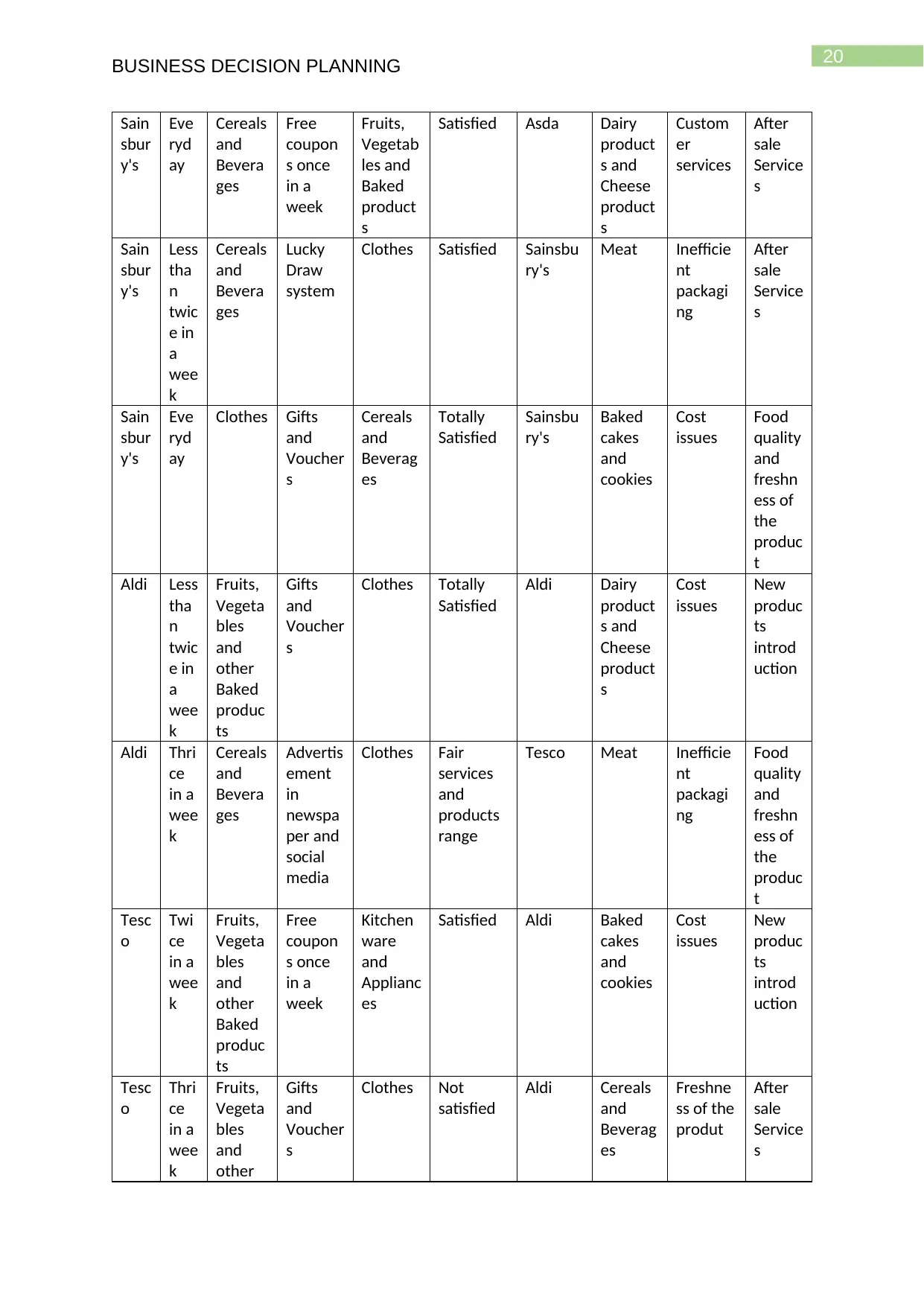
20
BUSINESS DECISION PLANNING
Sain
sbur
y's
Eve
ryd
ay
Cereals
and
Bevera
ges
Free
coupon
s once
in a
week
Fruits,
Vegetab
les and
Baked
product
s
Satisfied Asda Dairy
product
s and
Cheese
product
s
Custom
er
services
After
sale
Service
s
Sain
sbur
y's
Less
tha
n
twic
e in
a
wee
k
Cereals
and
Bevera
ges
Lucky
Draw
system
Clothes Satisfied Sainsbu
ry's
Meat Inefficie
nt
packagi
ng
After
sale
Service
s
Sain
sbur
y's
Eve
ryd
ay
Clothes Gifts
and
Voucher
s
Cereals
and
Beverag
es
Totally
Satisfied
Sainsbu
ry's
Baked
cakes
and
cookies
Cost
issues
Food
quality
and
freshn
ess of
the
produc
t
Aldi Less
tha
n
twic
e in
a
wee
k
Fruits,
Vegeta
bles
and
other
Baked
produc
ts
Gifts
and
Voucher
s
Clothes Totally
Satisfied
Aldi Dairy
product
s and
Cheese
product
s
Cost
issues
New
produc
ts
introd
uction
Aldi Thri
ce
in a
wee
k
Cereals
and
Bevera
ges
Advertis
ement
in
newspa
per and
social
media
Clothes Fair
services
and
products
range
Tesco Meat Inefficie
nt
packagi
ng
Food
quality
and
freshn
ess of
the
produc
t
Tesc
o
Twi
ce
in a
wee
k
Fruits,
Vegeta
bles
and
other
Baked
produc
ts
Free
coupon
s once
in a
week
Kitchen
ware
and
Applianc
es
Satisfied Aldi Baked
cakes
and
cookies
Cost
issues
New
produc
ts
introd
uction
Tesc
o
Thri
ce
in a
wee
k
Fruits,
Vegeta
bles
and
other
Gifts
and
Voucher
s
Clothes Not
satisfied
Aldi Cereals
and
Beverag
es
Freshne
ss of the
produt
After
sale
Service
s
BUSINESS DECISION PLANNING
Sain
sbur
y's
Eve
ryd
ay
Cereals
and
Bevera
ges
Free
coupon
s once
in a
week
Fruits,
Vegetab
les and
Baked
product
s
Satisfied Asda Dairy
product
s and
Cheese
product
s
Custom
er
services
After
sale
Service
s
Sain
sbur
y's
Less
tha
n
twic
e in
a
wee
k
Cereals
and
Bevera
ges
Lucky
Draw
system
Clothes Satisfied Sainsbu
ry's
Meat Inefficie
nt
packagi
ng
After
sale
Service
s
Sain
sbur
y's
Eve
ryd
ay
Clothes Gifts
and
Voucher
s
Cereals
and
Beverag
es
Totally
Satisfied
Sainsbu
ry's
Baked
cakes
and
cookies
Cost
issues
Food
quality
and
freshn
ess of
the
produc
t
Aldi Less
tha
n
twic
e in
a
wee
k
Fruits,
Vegeta
bles
and
other
Baked
produc
ts
Gifts
and
Voucher
s
Clothes Totally
Satisfied
Aldi Dairy
product
s and
Cheese
product
s
Cost
issues
New
produc
ts
introd
uction
Aldi Thri
ce
in a
wee
k
Cereals
and
Bevera
ges
Advertis
ement
in
newspa
per and
social
media
Clothes Fair
services
and
products
range
Tesco Meat Inefficie
nt
packagi
ng
Food
quality
and
freshn
ess of
the
produc
t
Tesc
o
Twi
ce
in a
wee
k
Fruits,
Vegeta
bles
and
other
Baked
produc
ts
Free
coupon
s once
in a
week
Kitchen
ware
and
Applianc
es
Satisfied Aldi Baked
cakes
and
cookies
Cost
issues
New
produc
ts
introd
uction
Tesc
o
Thri
ce
in a
wee
k
Fruits,
Vegeta
bles
and
other
Gifts
and
Voucher
s
Clothes Not
satisfied
Aldi Cereals
and
Beverag
es
Freshne
ss of the
produt
After
sale
Service
s
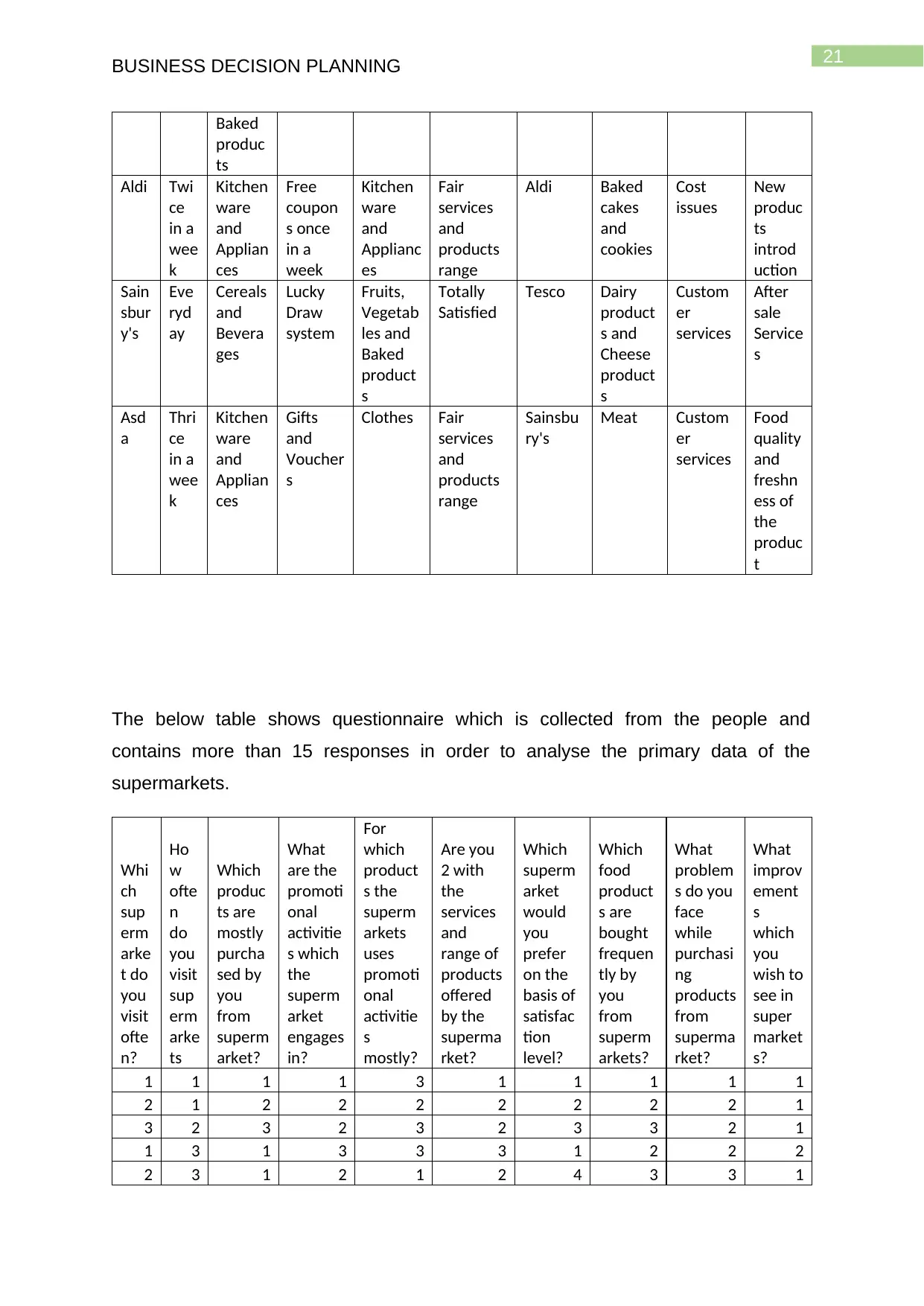
21
BUSINESS DECISION PLANNING
Baked
produc
ts
Aldi Twi
ce
in a
wee
k
Kitchen
ware
and
Applian
ces
Free
coupon
s once
in a
week
Kitchen
ware
and
Applianc
es
Fair
services
and
products
range
Aldi Baked
cakes
and
cookies
Cost
issues
New
produc
ts
introd
uction
Sain
sbur
y's
Eve
ryd
ay
Cereals
and
Bevera
ges
Lucky
Draw
system
Fruits,
Vegetab
les and
Baked
product
s
Totally
Satisfied
Tesco Dairy
product
s and
Cheese
product
s
Custom
er
services
After
sale
Service
s
Asd
a
Thri
ce
in a
wee
k
Kitchen
ware
and
Applian
ces
Gifts
and
Voucher
s
Clothes Fair
services
and
products
range
Sainsbu
ry's
Meat Custom
er
services
Food
quality
and
freshn
ess of
the
produc
t
The below table shows questionnaire which is collected from the people and
contains more than 15 responses in order to analyse the primary data of the
supermarkets.
Whi
ch
sup
erm
arke
t do
you
visit
ofte
n?
Ho
w
ofte
n
do
you
visit
sup
erm
arke
ts
Which
produc
ts are
mostly
purcha
sed by
you
from
superm
arket?
What
are the
promoti
onal
activitie
s which
the
superm
arket
engages
in?
For
which
product
s the
superm
arkets
uses
promoti
onal
activitie
s
mostly?
Are you
2 with
the
services
and
range of
products
offered
by the
superma
rket?
Which
superm
arket
would
you
prefer
on the
basis of
satisfac
tion
level?
Which
food
product
s are
bought
frequen
tly by
you
from
superm
arkets?
What
problem
s do you
face
while
purchasi
ng
products
from
superma
rket?
What
improv
ement
s
which
you
wish to
see in
super
market
s?
1 1 1 1 3 1 1 1 1 1
2 1 2 2 2 2 2 2 2 1
3 2 3 2 3 2 3 3 2 1
1 3 1 3 3 3 1 2 2 2
2 3 1 2 1 2 4 3 3 1
BUSINESS DECISION PLANNING
Baked
produc
ts
Aldi Twi
ce
in a
wee
k
Kitchen
ware
and
Applian
ces
Free
coupon
s once
in a
week
Kitchen
ware
and
Applianc
es
Fair
services
and
products
range
Aldi Baked
cakes
and
cookies
Cost
issues
New
produc
ts
introd
uction
Sain
sbur
y's
Eve
ryd
ay
Cereals
and
Bevera
ges
Lucky
Draw
system
Fruits,
Vegetab
les and
Baked
product
s
Totally
Satisfied
Tesco Dairy
product
s and
Cheese
product
s
Custom
er
services
After
sale
Service
s
Asd
a
Thri
ce
in a
wee
k
Kitchen
ware
and
Applian
ces
Gifts
and
Voucher
s
Clothes Fair
services
and
products
range
Sainsbu
ry's
Meat Custom
er
services
Food
quality
and
freshn
ess of
the
produc
t
The below table shows questionnaire which is collected from the people and
contains more than 15 responses in order to analyse the primary data of the
supermarkets.
Whi
ch
sup
erm
arke
t do
you
visit
ofte
n?
Ho
w
ofte
n
do
you
visit
sup
erm
arke
ts
Which
produc
ts are
mostly
purcha
sed by
you
from
superm
arket?
What
are the
promoti
onal
activitie
s which
the
superm
arket
engages
in?
For
which
product
s the
superm
arkets
uses
promoti
onal
activitie
s
mostly?
Are you
2 with
the
services
and
range of
products
offered
by the
superma
rket?
Which
superm
arket
would
you
prefer
on the
basis of
satisfac
tion
level?
Which
food
product
s are
bought
frequen
tly by
you
from
superm
arkets?
What
problem
s do you
face
while
purchasi
ng
products
from
superma
rket?
What
improv
ement
s
which
you
wish to
see in
super
market
s?
1 1 1 1 3 1 1 1 1 1
2 1 2 2 2 2 2 2 2 1
3 2 3 2 3 2 3 3 2 1
1 3 1 3 3 3 1 2 2 2
2 3 1 2 1 2 4 3 3 1
Secure Best Marks with AI Grader
Need help grading? Try our AI Grader for instant feedback on your assignments.
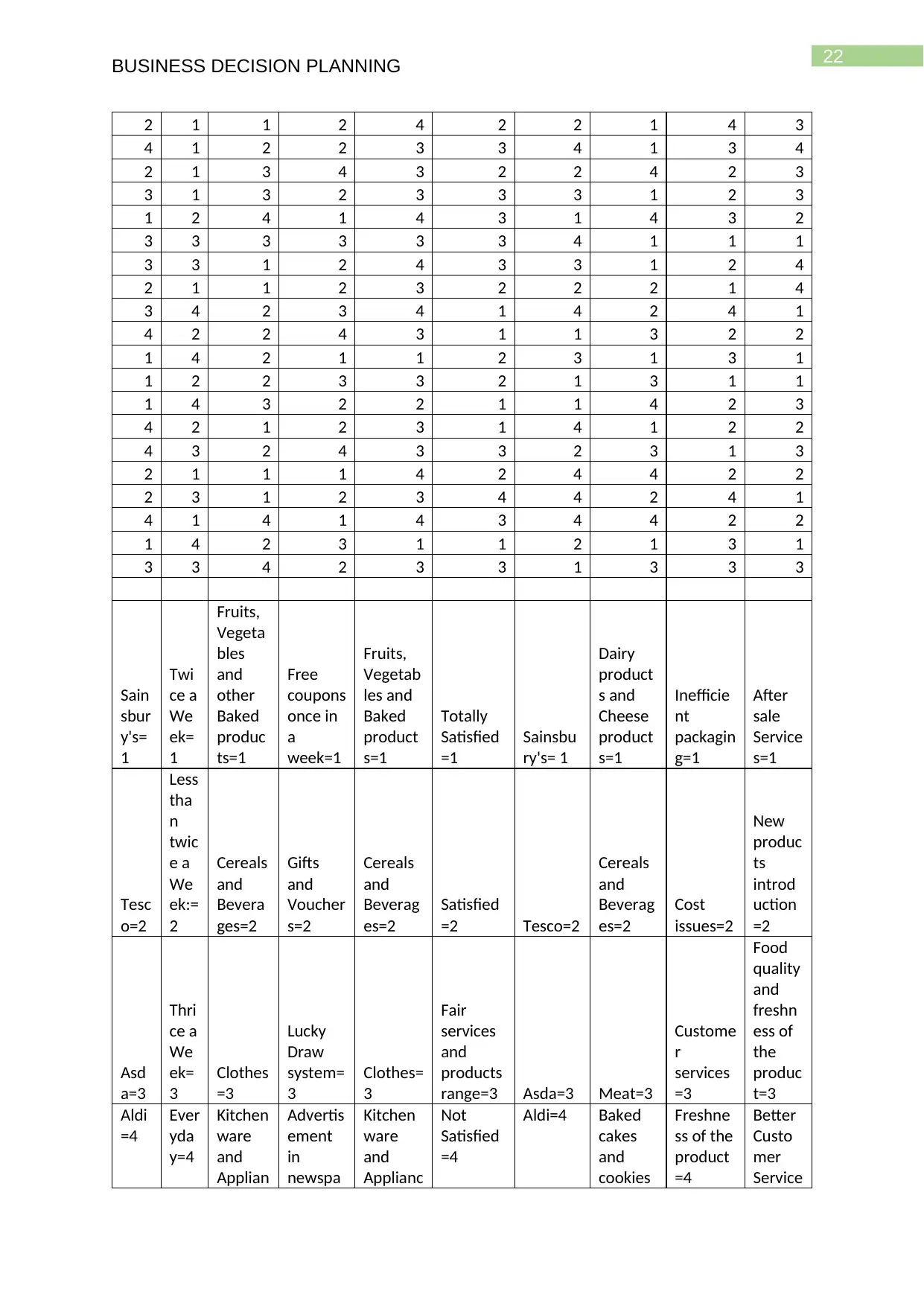
22
BUSINESS DECISION PLANNING
2 1 1 2 4 2 2 1 4 3
4 1 2 2 3 3 4 1 3 4
2 1 3 4 3 2 2 4 2 3
3 1 3 2 3 3 3 1 2 3
1 2 4 1 4 3 1 4 3 2
3 3 3 3 3 3 4 1 1 1
3 3 1 2 4 3 3 1 2 4
2 1 1 2 3 2 2 2 1 4
3 4 2 3 4 1 4 2 4 1
4 2 2 4 3 1 1 3 2 2
1 4 2 1 1 2 3 1 3 1
1 2 2 3 3 2 1 3 1 1
1 4 3 2 2 1 1 4 2 3
4 2 1 2 3 1 4 1 2 2
4 3 2 4 3 3 2 3 1 3
2 1 1 1 4 2 4 4 2 2
2 3 1 2 3 4 4 2 4 1
4 1 4 1 4 3 4 4 2 2
1 4 2 3 1 1 2 1 3 1
3 3 4 2 3 3 1 3 3 3
Sain
sbur
y's=
1
Twi
ce a
We
ek=
1
Fruits,
Vegeta
bles
and
other
Baked
produc
ts=1
Free
coupons
once in
a
week=1
Fruits,
Vegetab
les and
Baked
product
s=1
Totally
Satisfied
=1
Sainsbu
ry's= 1
Dairy
product
s and
Cheese
product
s=1
Inefficie
nt
packagin
g=1
After
sale
Service
s=1
Tesc
o=2
Less
tha
n
twic
e a
We
ek:=
2
Cereals
and
Bevera
ges=2
Gifts
and
Voucher
s=2
Cereals
and
Beverag
es=2
Satisfied
=2 Tesco=2
Cereals
and
Beverag
es=2
Cost
issues=2
New
produc
ts
introd
uction
=2
Asd
a=3
Thri
ce a
We
ek=
3
Clothes
=3
Lucky
Draw
system=
3
Clothes=
3
Fair
services
and
products
range=3 Asda=3 Meat=3
Custome
r
services
=3
Food
quality
and
freshn
ess of
the
produc
t=3
Aldi
=4
Ever
yda
y=4
Kitchen
ware
and
Applian
Advertis
ement
in
newspa
Kitchen
ware
and
Applianc
Not
Satisfied
=4
Aldi=4 Baked
cakes
and
cookies
Freshne
ss of the
product
=4
Better
Custo
mer
Service
BUSINESS DECISION PLANNING
2 1 1 2 4 2 2 1 4 3
4 1 2 2 3 3 4 1 3 4
2 1 3 4 3 2 2 4 2 3
3 1 3 2 3 3 3 1 2 3
1 2 4 1 4 3 1 4 3 2
3 3 3 3 3 3 4 1 1 1
3 3 1 2 4 3 3 1 2 4
2 1 1 2 3 2 2 2 1 4
3 4 2 3 4 1 4 2 4 1
4 2 2 4 3 1 1 3 2 2
1 4 2 1 1 2 3 1 3 1
1 2 2 3 3 2 1 3 1 1
1 4 3 2 2 1 1 4 2 3
4 2 1 2 3 1 4 1 2 2
4 3 2 4 3 3 2 3 1 3
2 1 1 1 4 2 4 4 2 2
2 3 1 2 3 4 4 2 4 1
4 1 4 1 4 3 4 4 2 2
1 4 2 3 1 1 2 1 3 1
3 3 4 2 3 3 1 3 3 3
Sain
sbur
y's=
1
Twi
ce a
We
ek=
1
Fruits,
Vegeta
bles
and
other
Baked
produc
ts=1
Free
coupons
once in
a
week=1
Fruits,
Vegetab
les and
Baked
product
s=1
Totally
Satisfied
=1
Sainsbu
ry's= 1
Dairy
product
s and
Cheese
product
s=1
Inefficie
nt
packagin
g=1
After
sale
Service
s=1
Tesc
o=2
Less
tha
n
twic
e a
We
ek:=
2
Cereals
and
Bevera
ges=2
Gifts
and
Voucher
s=2
Cereals
and
Beverag
es=2
Satisfied
=2 Tesco=2
Cereals
and
Beverag
es=2
Cost
issues=2
New
produc
ts
introd
uction
=2
Asd
a=3
Thri
ce a
We
ek=
3
Clothes
=3
Lucky
Draw
system=
3
Clothes=
3
Fair
services
and
products
range=3 Asda=3 Meat=3
Custome
r
services
=3
Food
quality
and
freshn
ess of
the
produc
t=3
Aldi
=4
Ever
yda
y=4
Kitchen
ware
and
Applian
Advertis
ement
in
newspa
Kitchen
ware
and
Applianc
Not
Satisfied
=4
Aldi=4 Baked
cakes
and
cookies
Freshne
ss of the
product
=4
Better
Custo
mer
Service
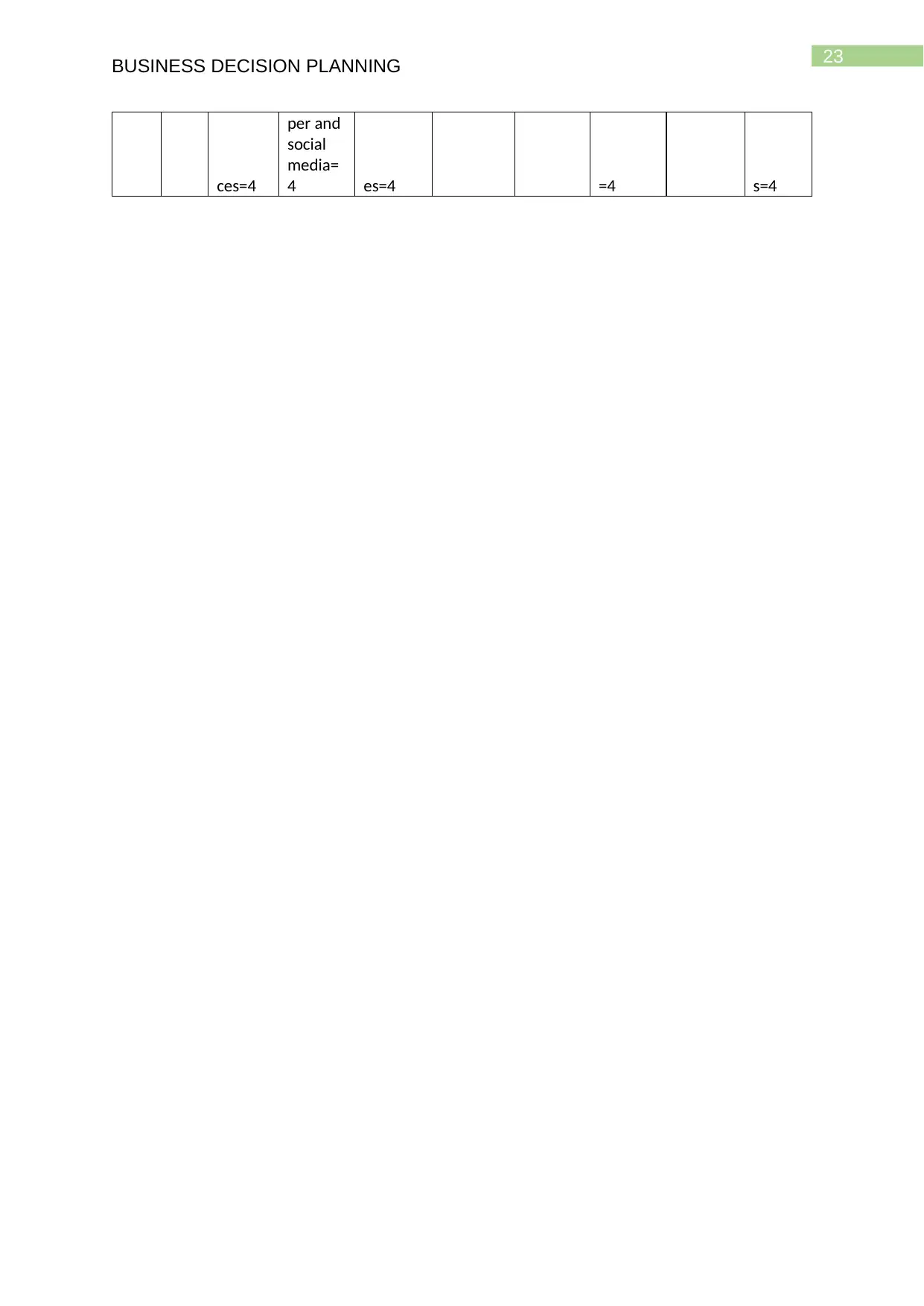
23
BUSINESS DECISION PLANNING
ces=4
per and
social
media=
4 es=4 =4 s=4
BUSINESS DECISION PLANNING
ces=4
per and
social
media=
4 es=4 =4 s=4
1 out of 24
Related Documents
Your All-in-One AI-Powered Toolkit for Academic Success.
+13062052269
info@desklib.com
Available 24*7 on WhatsApp / Email
![[object Object]](/_next/static/media/star-bottom.7253800d.svg)
Unlock your academic potential
© 2024 | Zucol Services PVT LTD | All rights reserved.




